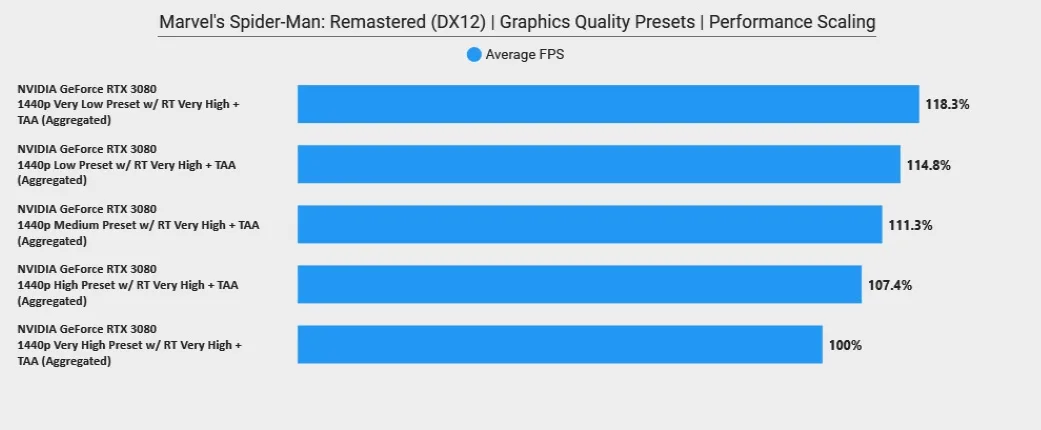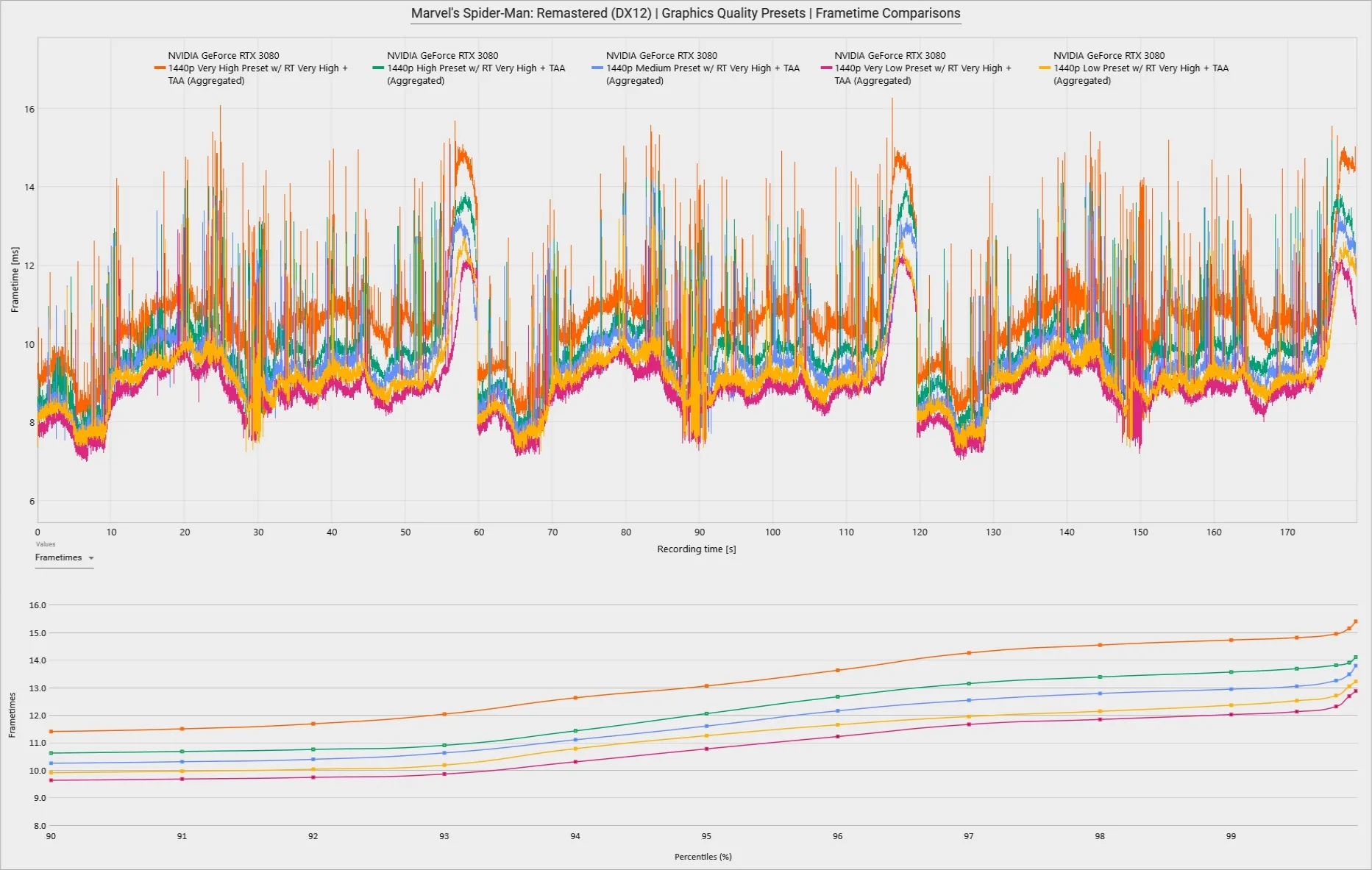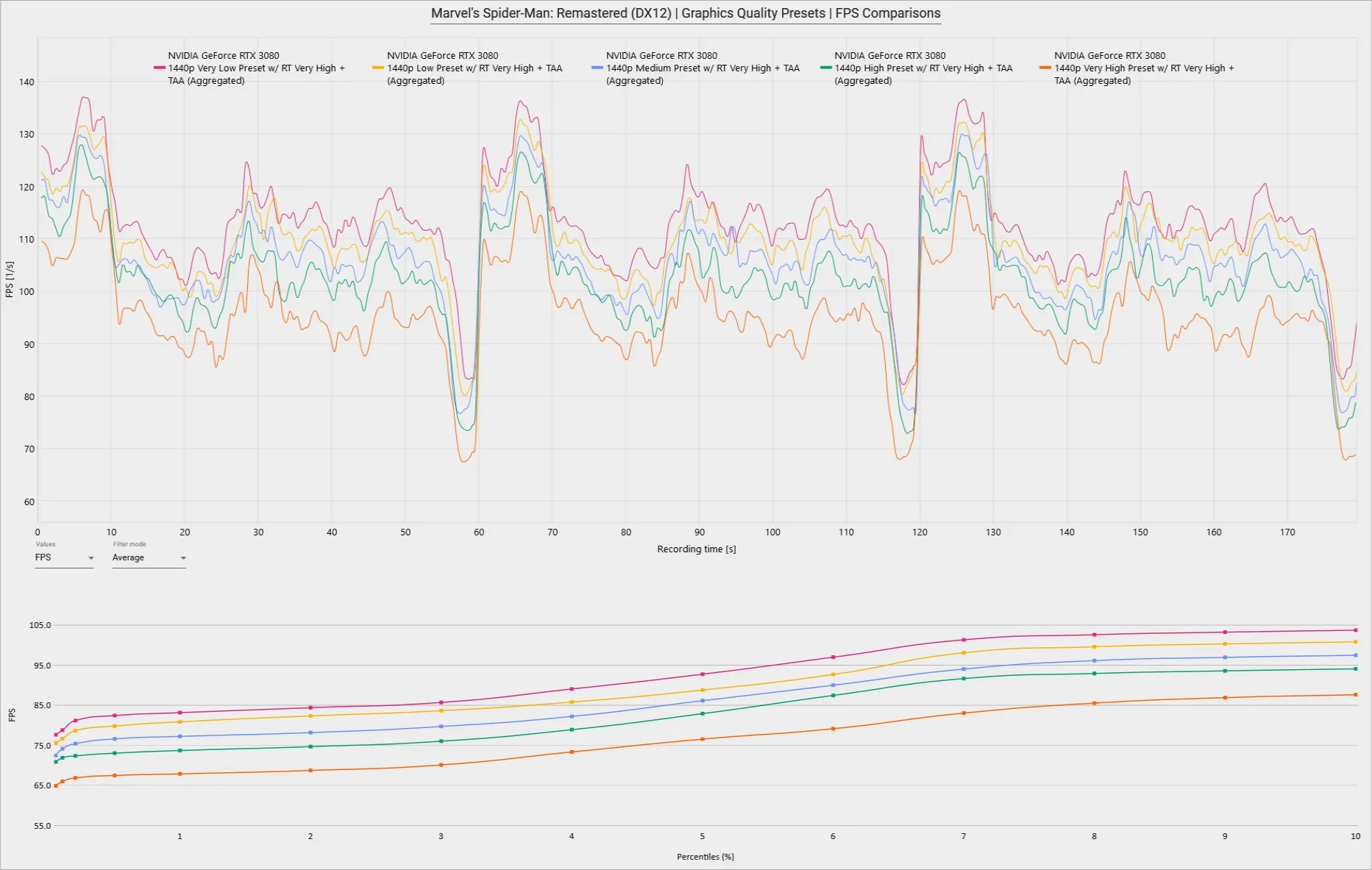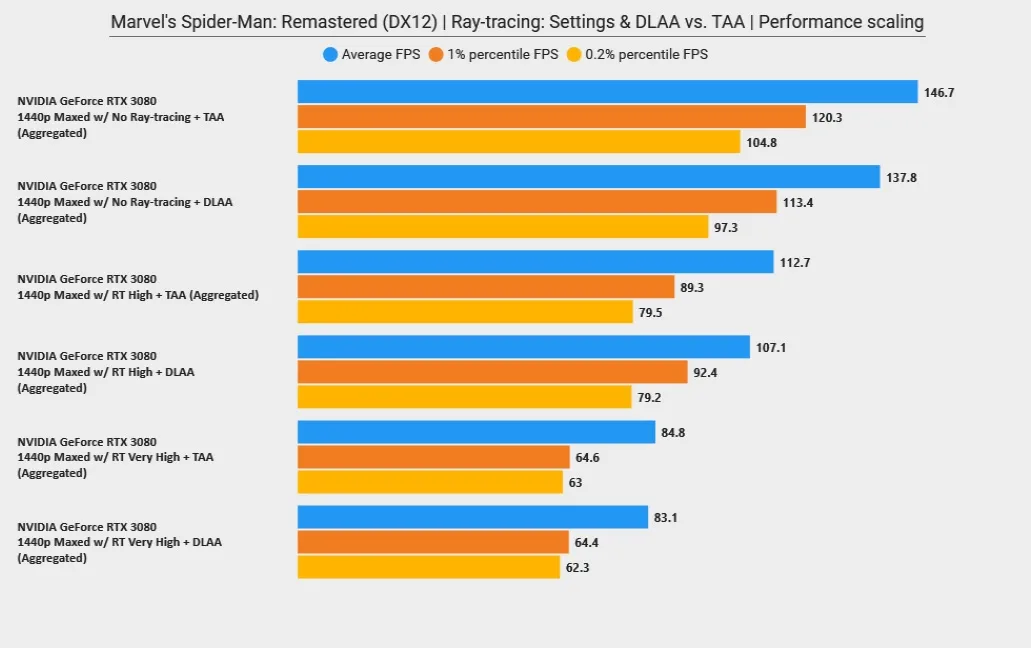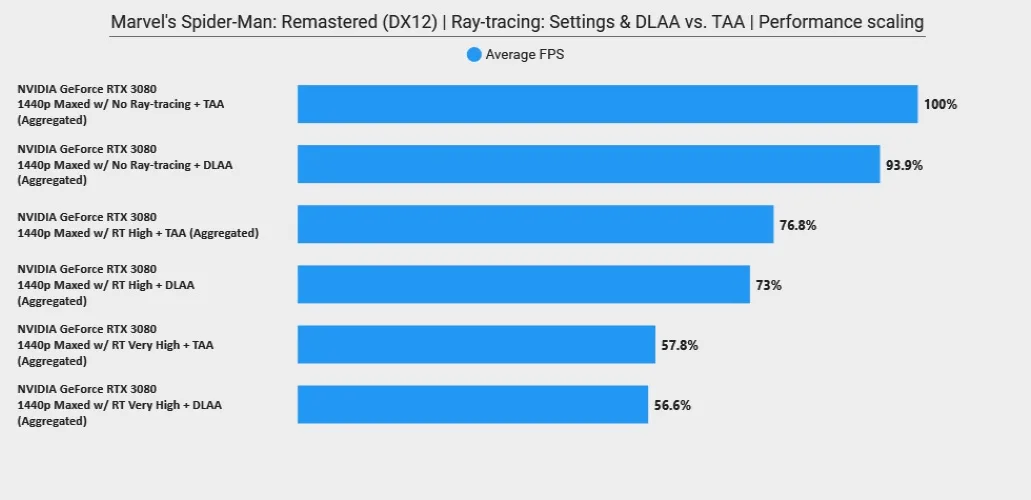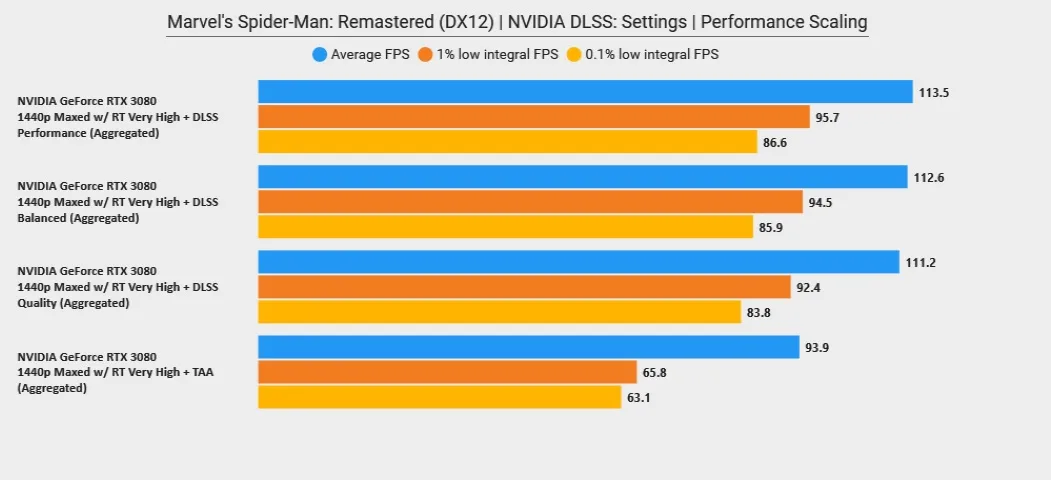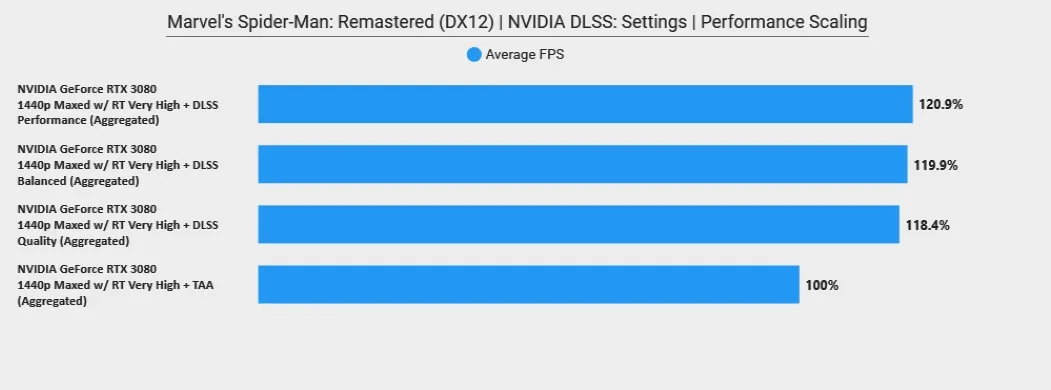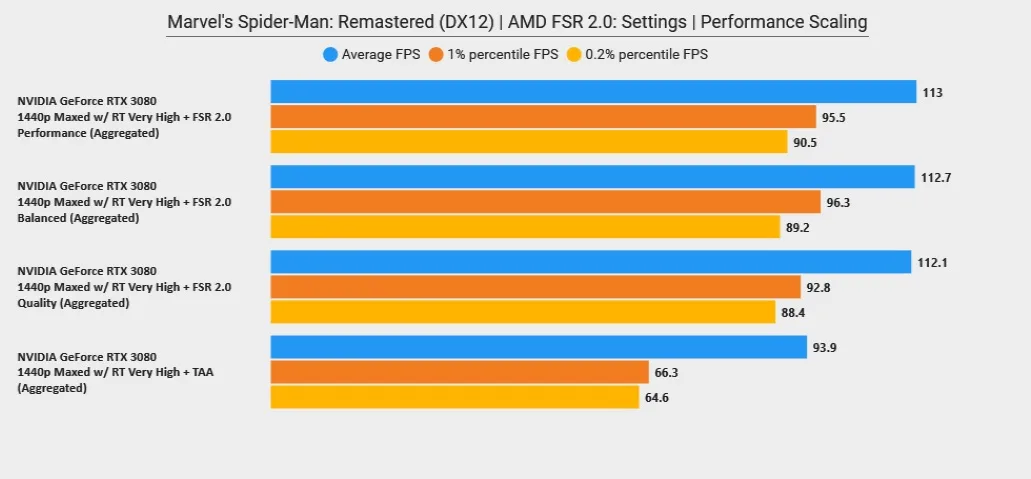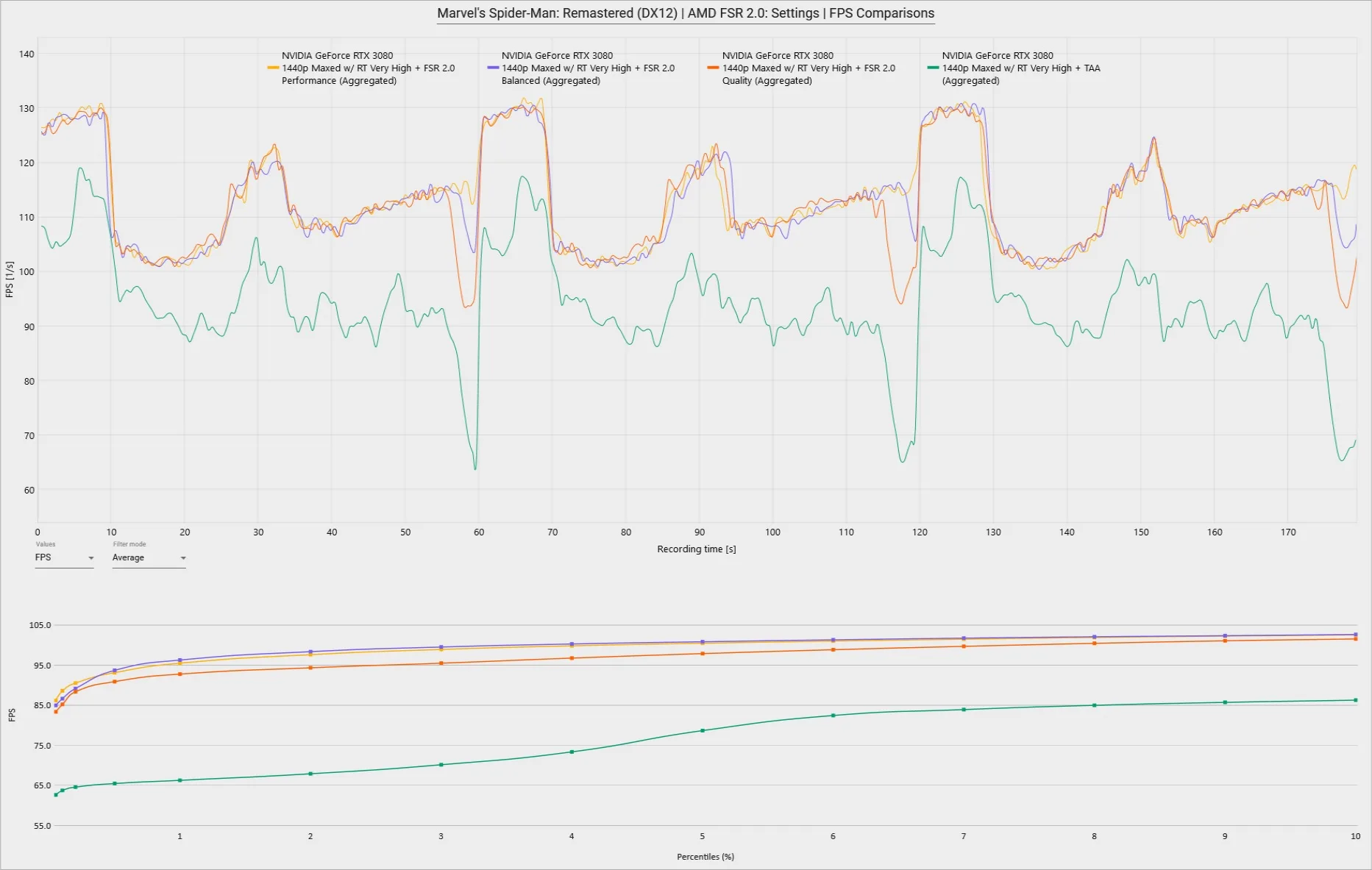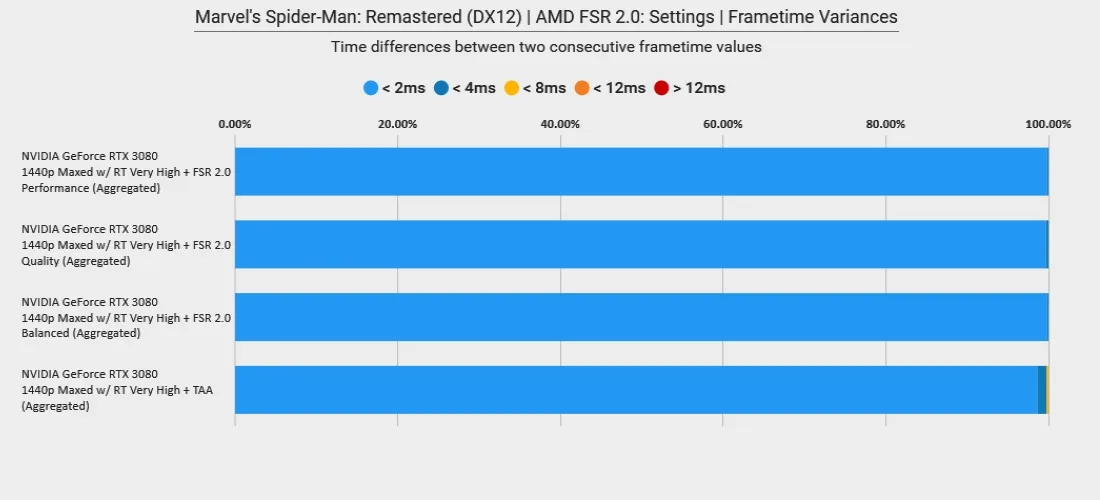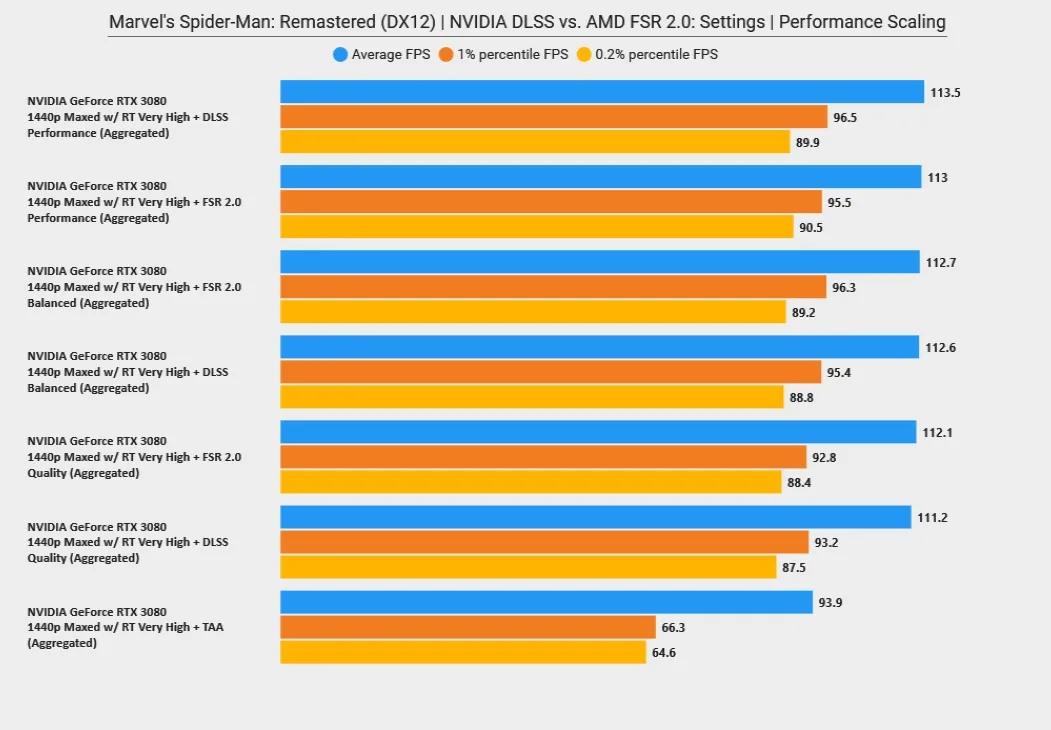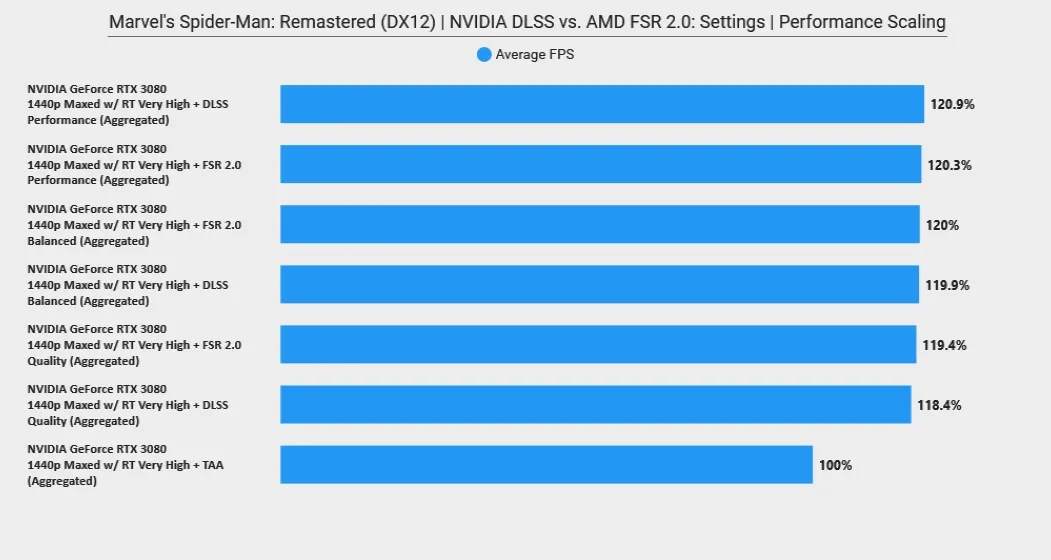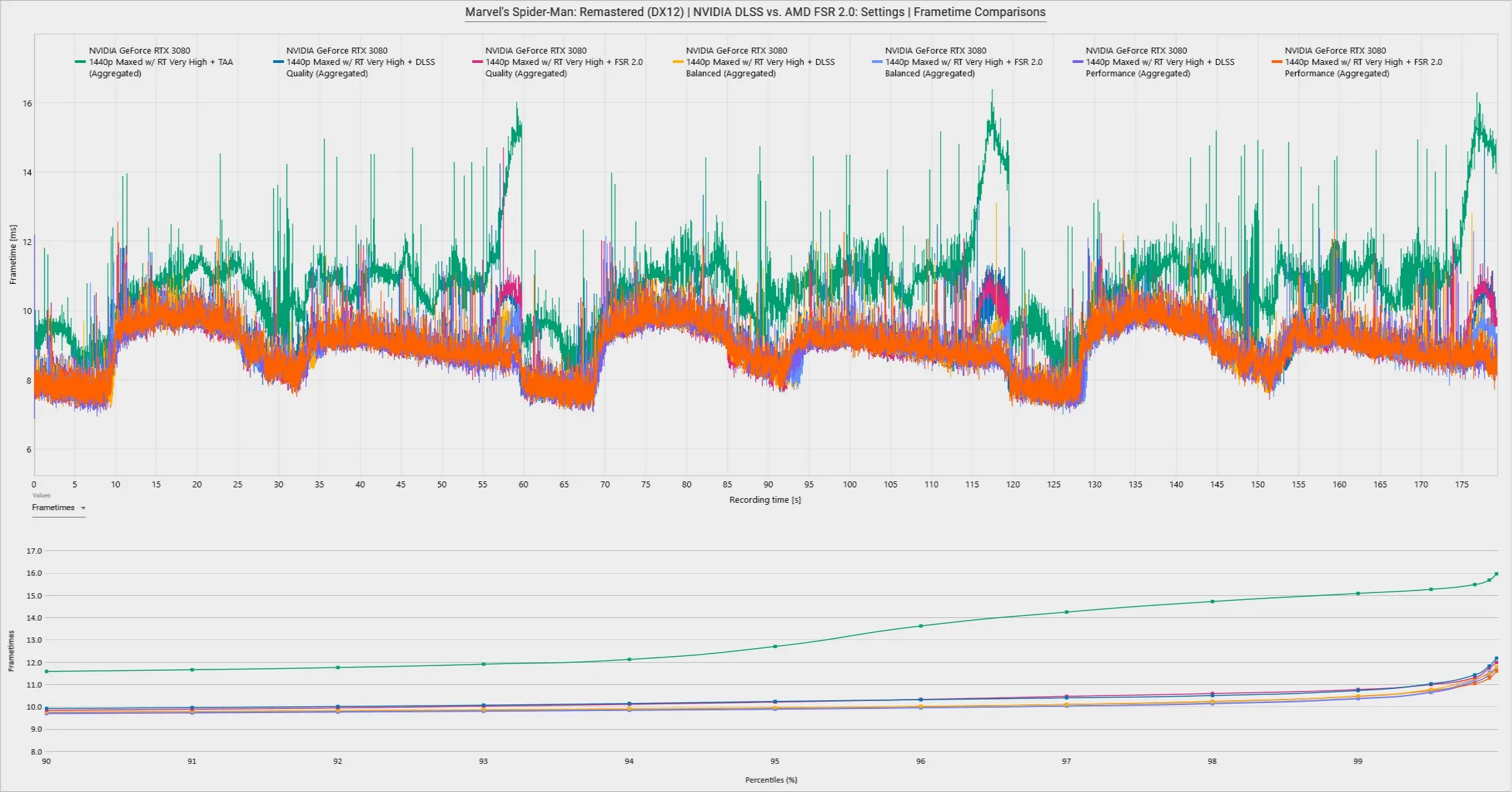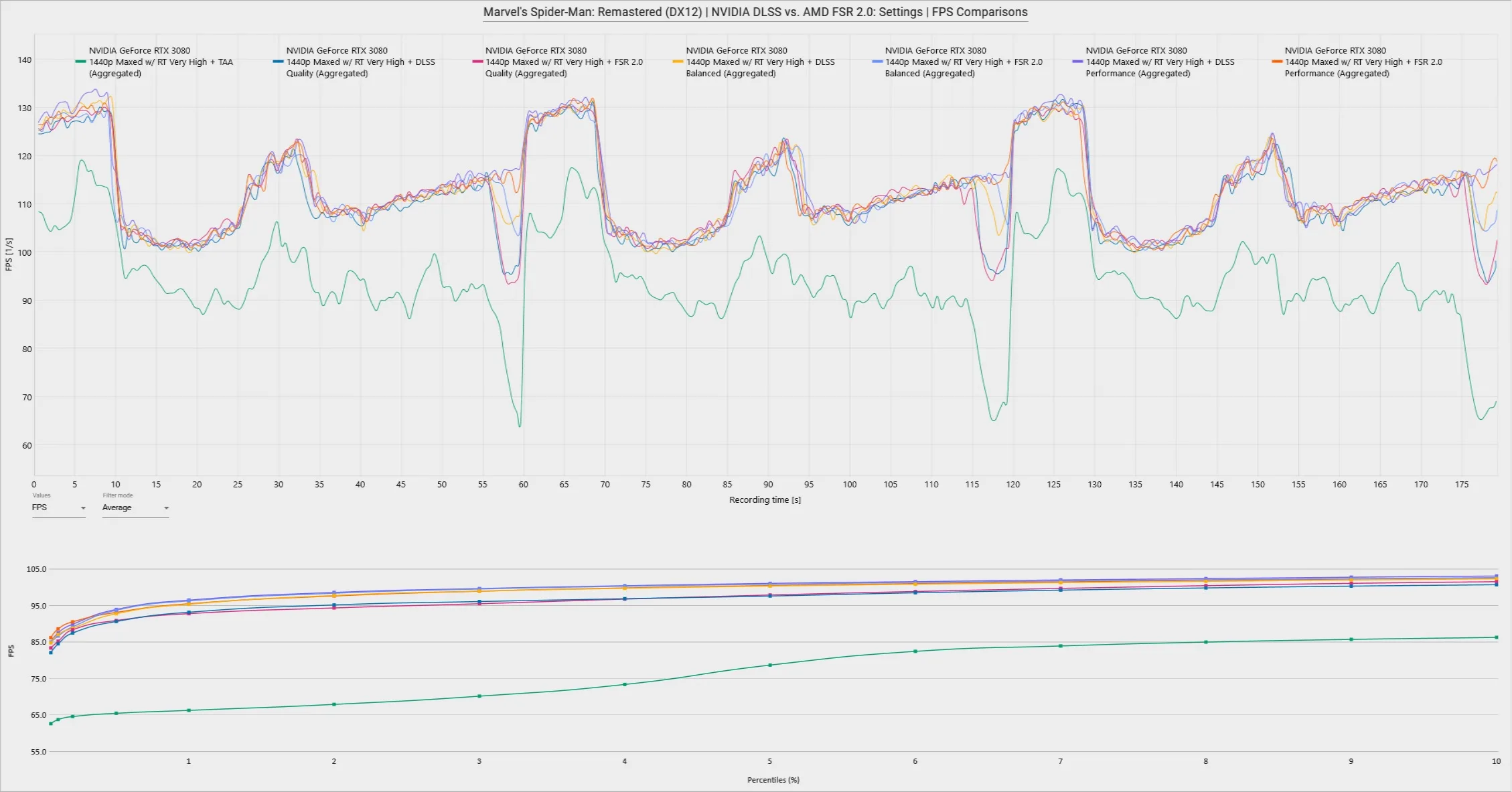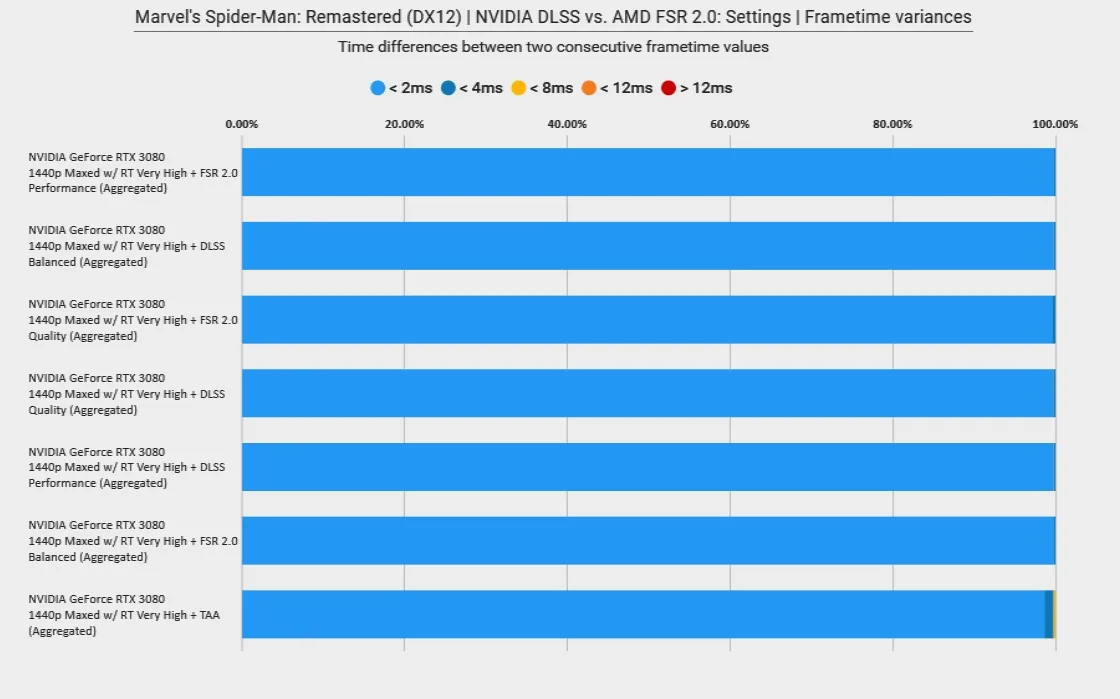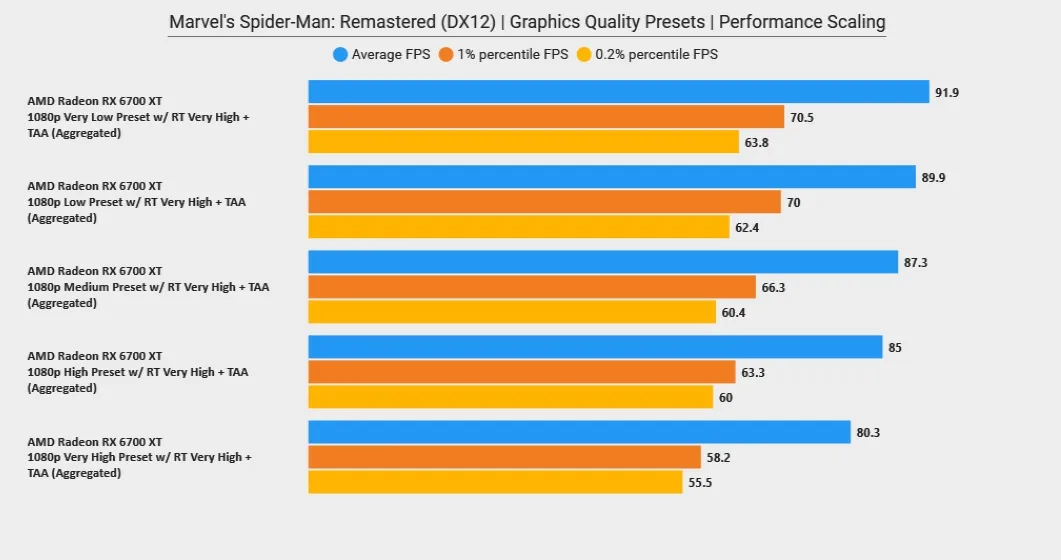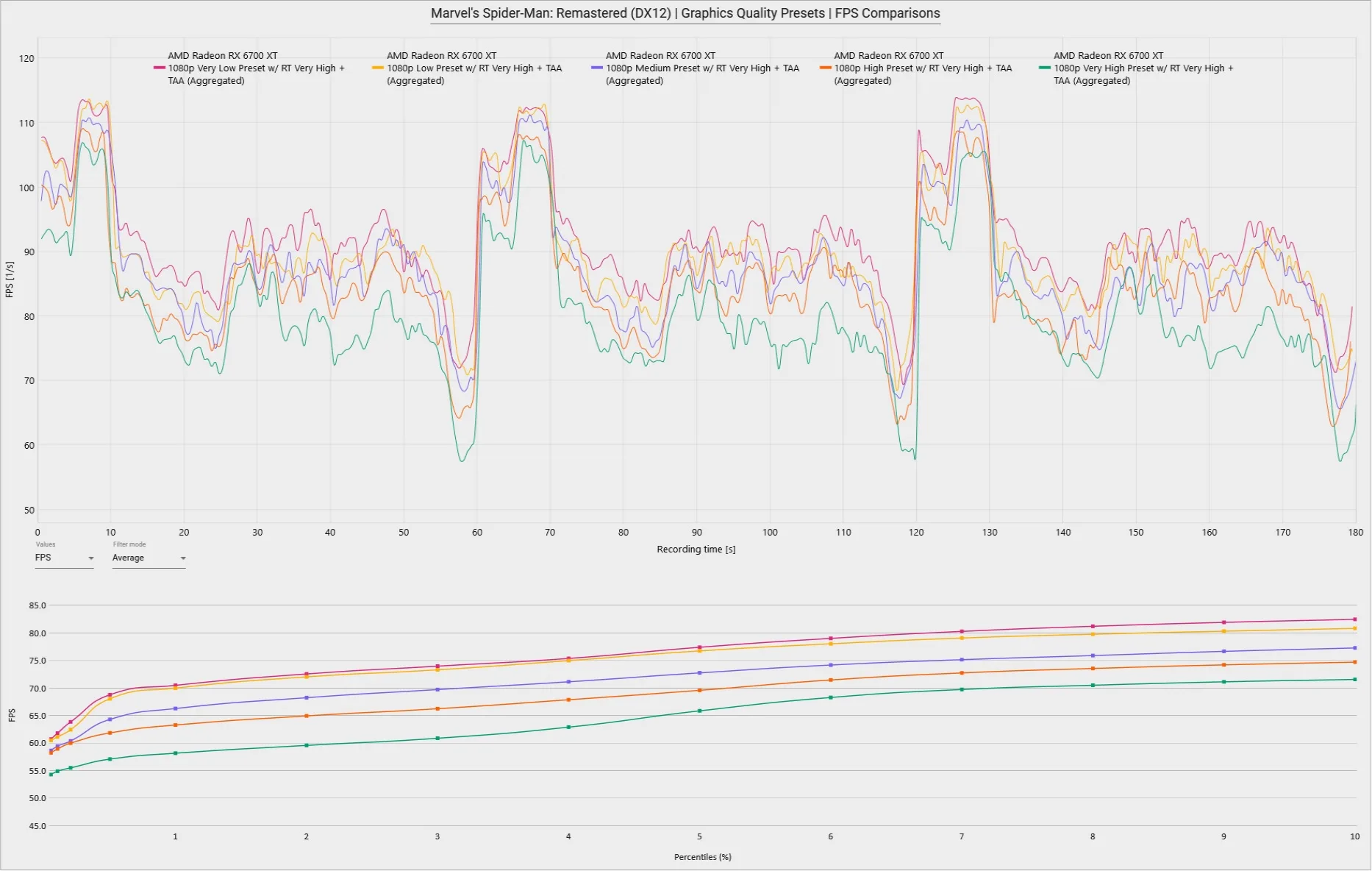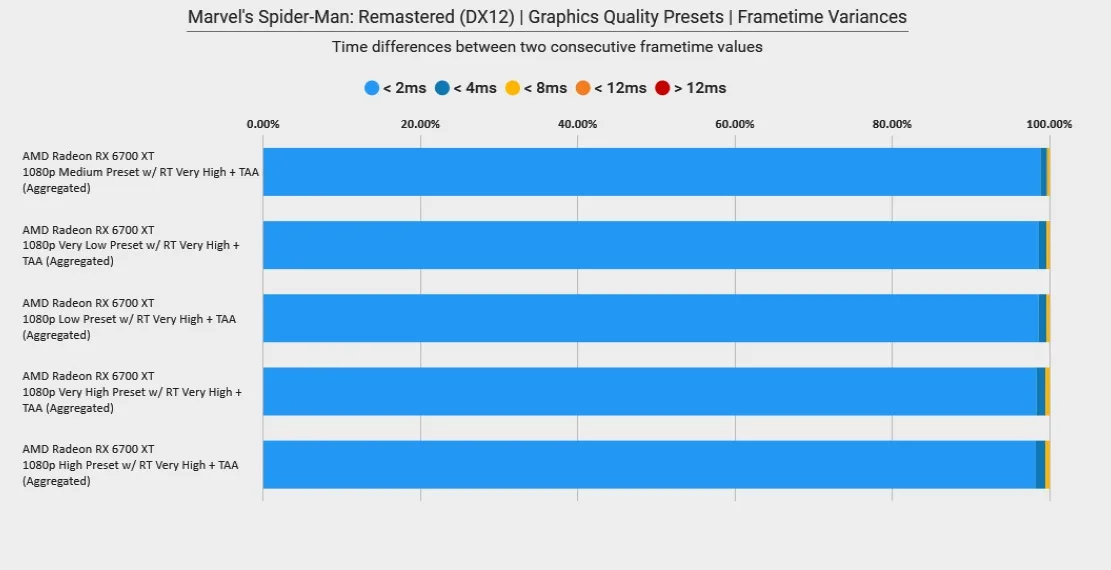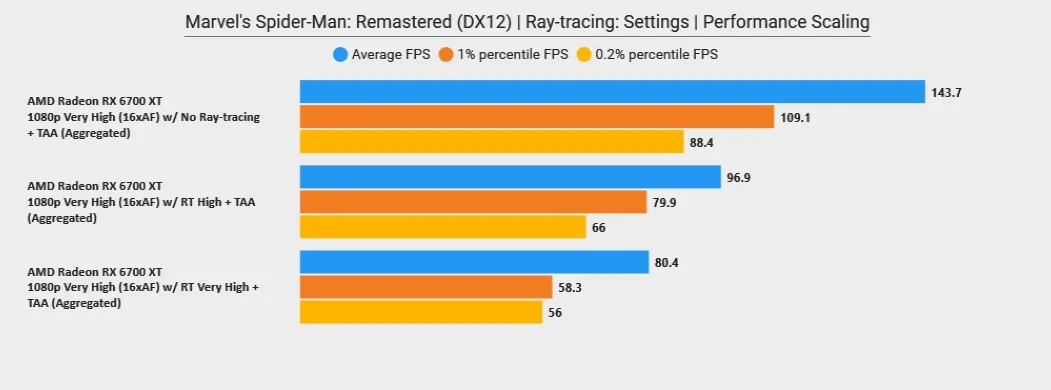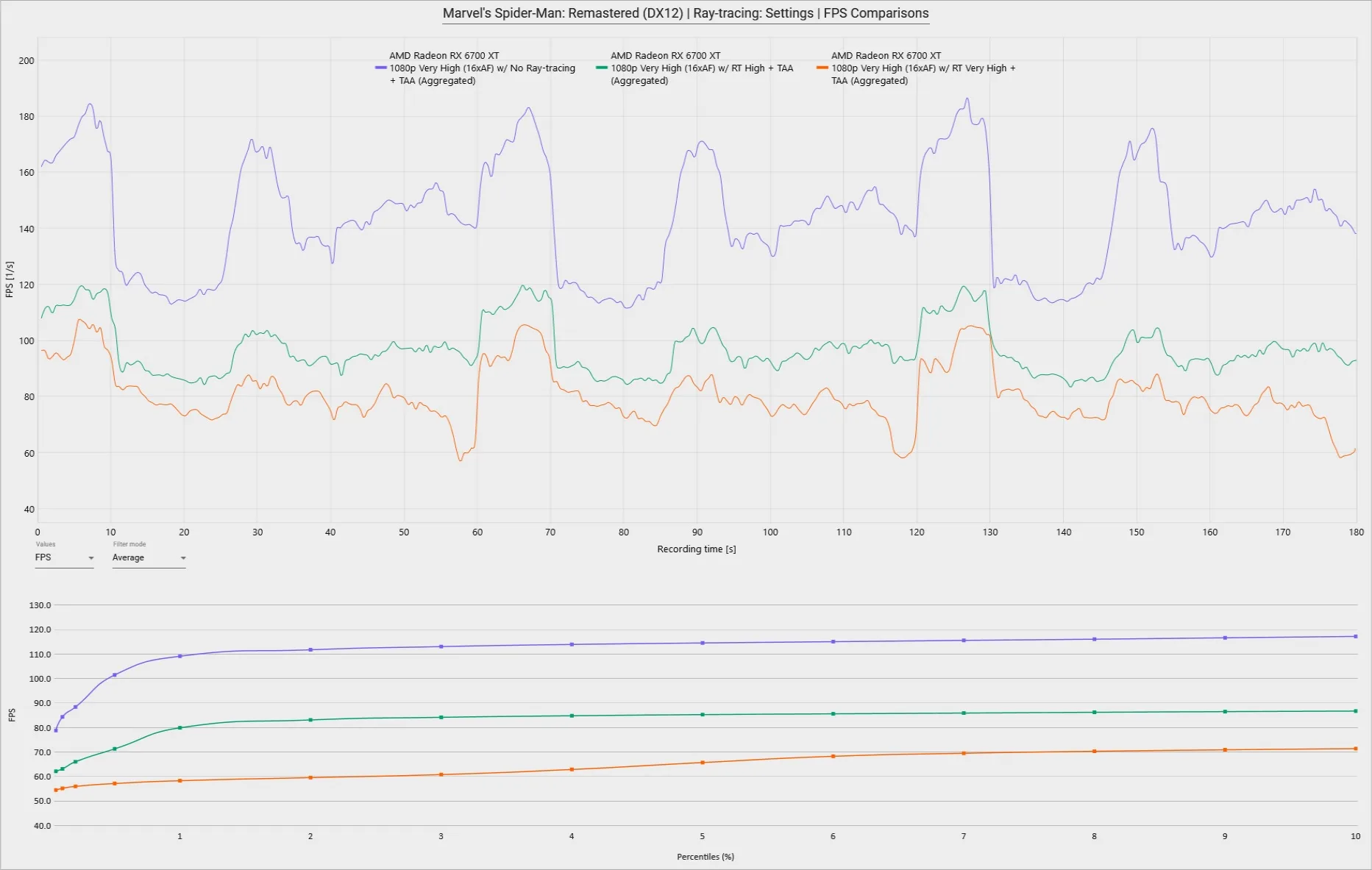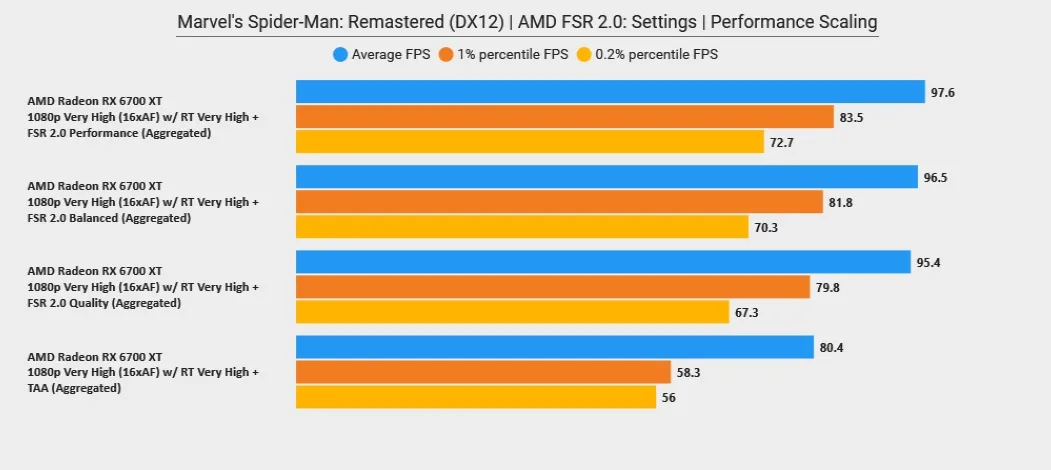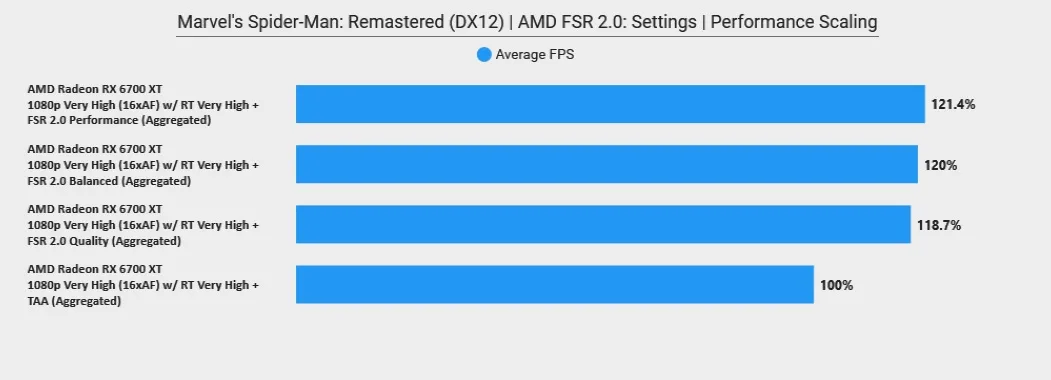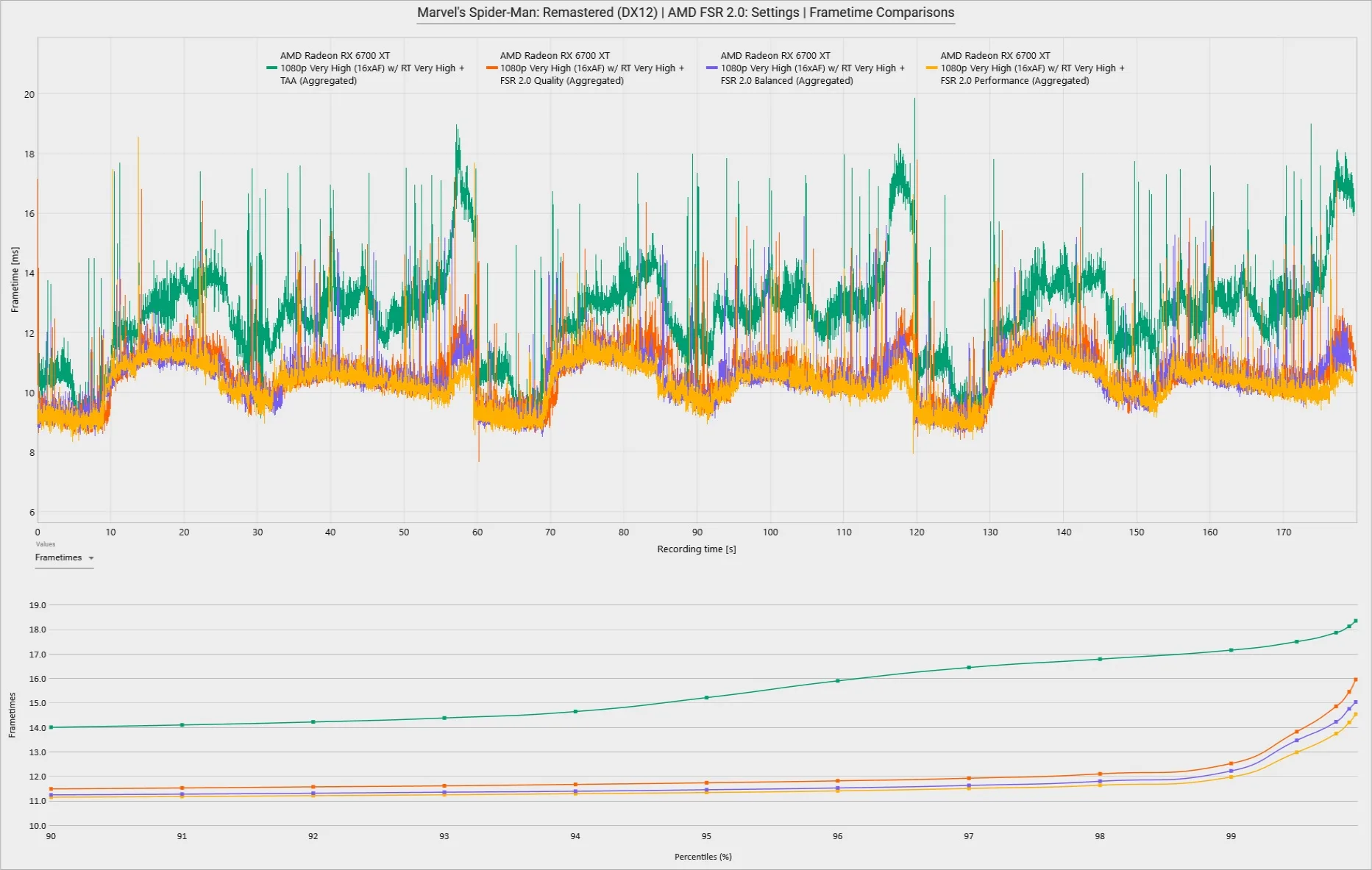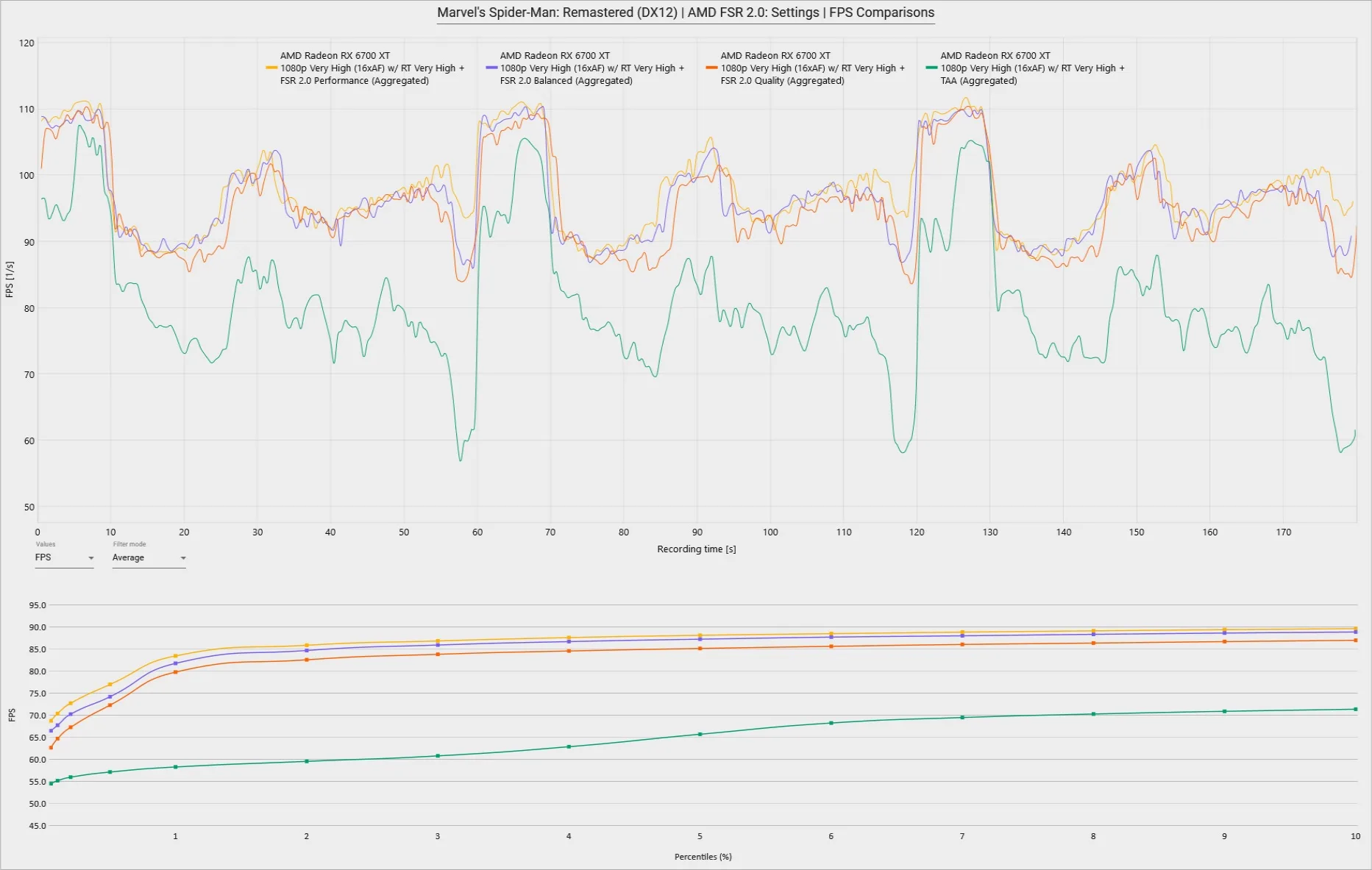Spider-Man Remastered PC Updated Performance Review featuring Image Quality & Ray Tracing with 11 Cards
After spending many hours completing the Spider-Man Remastered main story, and being unable to tear ourselves away from the screen, BTR’s editors recommend it as a great game with a few flaws. Rodrigo, Mark, and Mario have collaborated to produce this review, each of us playing it for 20 or more hours. We cover the gameplay, updated performance with Thursday’s patch, and IQ (image quality) which includes ray tracing and testing AMD’s and NVIDIA’s upscaling solutions.
Spider-Man Remastered was released originally as a PS4 exclusive in 2018 and two years later remastered for PS5. Sony then gave it a complete makeover when they ported it to PC complete with ray traced reflections, and together with all the DLC, it was released ten days ago on August 12, 2022. Sony worked quickly to patch the game six days later, significantly improving ray traced performance while addressing bugs. We have tested the performance of 11 ray tracing capable NVIDIA and AMD cards because reflections add a lot of value to playing the game much like Control does. Since Spider-Man: Remastered is a fast-paced game, it’s important to keep framerates high.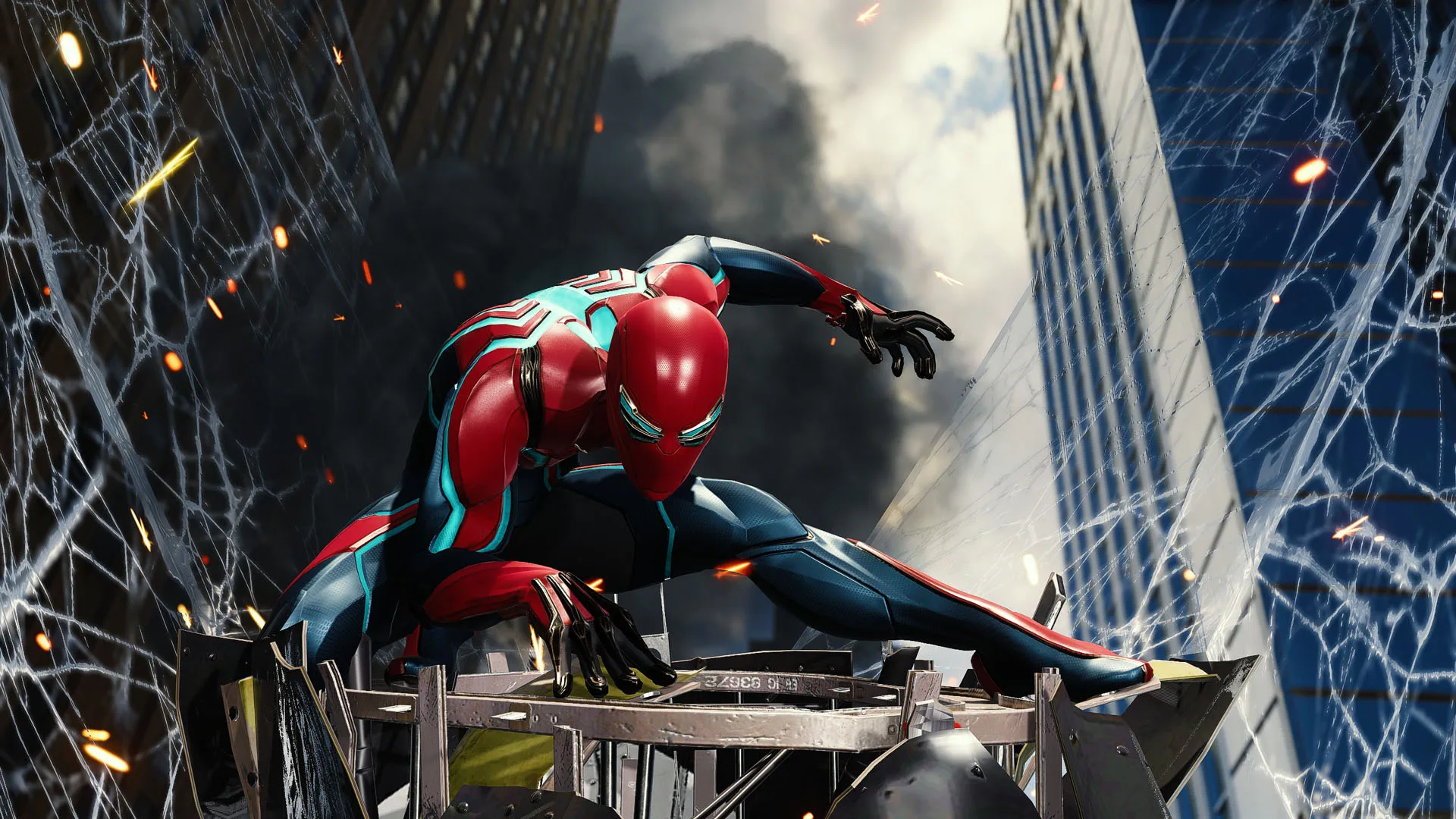
Rodrigo’s impressions
After completing the second act of the game’s main story arc, I can recommend Spider-Man: Remastered for PC. So far, I have played for more than 20 hours and tested it for more than 30 hours. I like some aspects so much, and a few I like less, but the final balance is very positive. About half the time, I played it on an RTX 3080 at 1440p resolution with max settings, DLAA, and very high ray-tracing. For the second part of the game, I used an RX 6700 XT at 1080p with maximum settings, TAA, and no ray-tracing.
First, I liked the narrative in the purest style of any Marvel superhero and villain movie. The story offers a good mix of emotions, frenetic action scenes, and somewhat trivial dialogues with light doses of humor that, despite their simplicity, accompany the development of the main plot very well.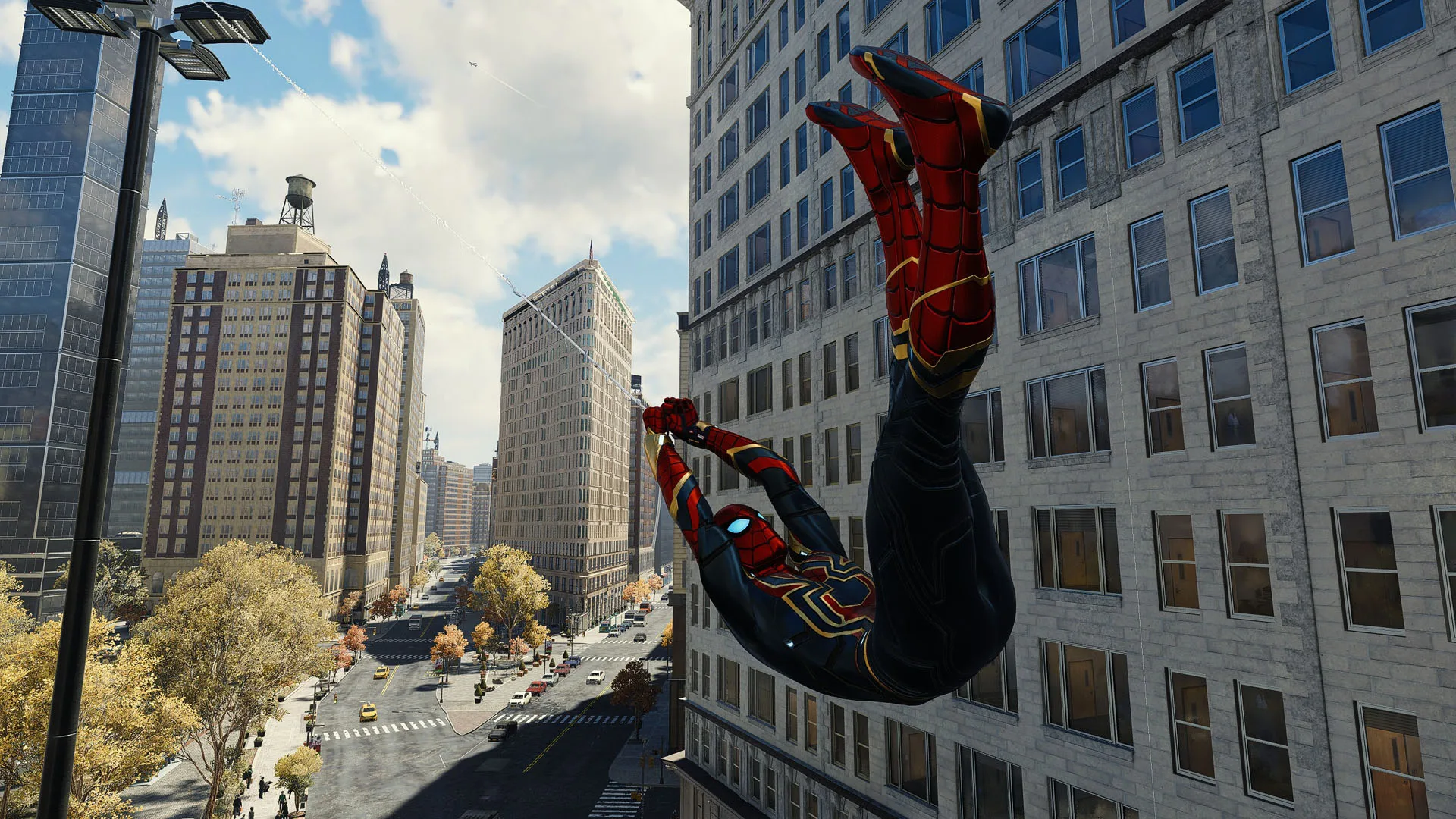
Second, I enjoyed its gameplay, which offers different styles, techniques, and combat movements. From some more focused on melee-type approaches and fights to more strategic ones in which we can combine blows and the use of various “spider” combat gadgets, or even purely stealth-based. It’s also great to use all of Spider-Man’s skills to fight enemies and discover, explore, and traverse the different areas of New York City. Swinging between buildings, doing stunts, and chasing or searching for targets is a delight. Spider-Man: Remastered also offers some interesting side quests, adding more depth to the main story and increasing our playtime.
Regarding the development of our Spider-Man, the game offers three trees of “arachnid” skills that we unlock and acquire by distributing skill points as we level up and earn experience points through our actions and completing game missions. We can specialize more in a type of skill, but this may not make sense as the story progresses, and we likely end up developing all the skill trees to maximize our chances of success.
The graphical and visual section is also great, thanks to the graphics enhancements for adapting it to the PC gaming platform and the addition of real-time ray-traced reflections. Also noteworthy is the effort the developers put into recreating in detail and bringing to life the different areas, icons, and monuments of New York City.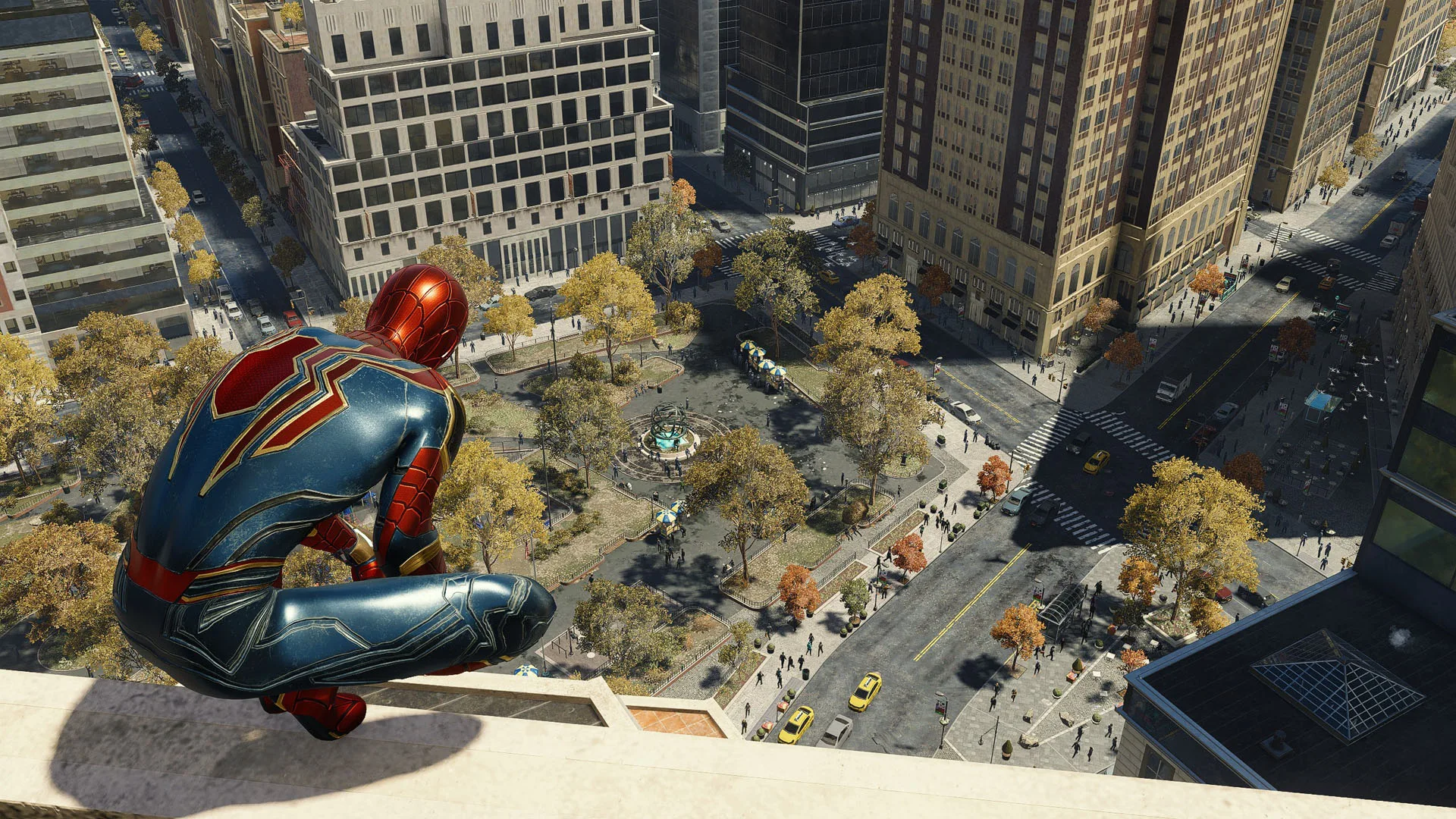
Spider-Man: Remastered is gorgeous and fun to play. The performance optimization is overall pretty good. With an RTX 3080, I get 80+ FPS average at 1440p resolution, “maxed-out” settings, and ray-tracing very-high settings with NVIDIA DLAA. Frame-pacing is not perfect but decent overall. The stutter count is pretty much zero (monitored via CapFrameX with RTSS) at all times during action gameplay (only capturing some minor stutters in menus and during cinematic sequences, but that’s very common in most games).
The RX 6700 XT was quite limited at 1440p. For this game, it’s an optimal card to play at 1080p with “Very High (16xAF)” settings but without ray-tracing. With ray-tracing (“High” or “Very High” settings) at 1080p, this card struggles quite a bit and shows FPS drops below 60, so you will have to resort to activating FSR 2.0 Quality. However, any scaling method and setting (with or without ray-tracing enabled) also come with the issue of low GPU usage and a high CPU limitation when traversing the city outdoors. Therefore, for the overall smoothest experience, I recommend using the Radeon RX 6700 XT with “maxed-out” or “Very High (16xAF)” settings but without enabling ray-tracing or FSR 2.0 scaling.
All in all, it’s a damn good game with a good narrative, story plot, and action gameplay, but for me, some collecting, grinding, and photography activities to improve our character and unveil the map felt somewhat repetitive. Overall, another good port from Sony, like Days Gone, God of War, or Horizon Zero Dawn.
However, the game still needs a few patches to achieve a stable state on most systems and fix some bugs and graphics glitches. Users with NVIDIA and AMD graphics cards have reported occasional game crashes, freezes, or lock-ups during gameplay. So far, the game has crashed only three times for me, but it has never been game-breaking for me. Also, DLSS and FSR 2.0 settings don’t scale well on 1440p and lower resolutions due to subpar GPU usage and high CPU limitation when using these scaling methods.
Therefore, considering all the above, I rate it an 8 out of 10 as a very good game.
Mark’s Comments, IQ, and Performance Benching
I agree that Spider-Man: Remastered deserves at least an 8/10 as a solid game. I played through the main quest within its first three days after release in about 24 hours using first a BenQ 32″ 4K display and then an LG C1 48″ OLED 120Hz display with an RTX 3080 Ti. The HDR was a bit too light, but otherwise, the game was very much like a great Spider-Man cinematic experience. I had a few more bugs than Rodrigo – after all, I expected bugs from a day one release Spider-Man game – but none of the relatively rare crashes to desktop lost progress.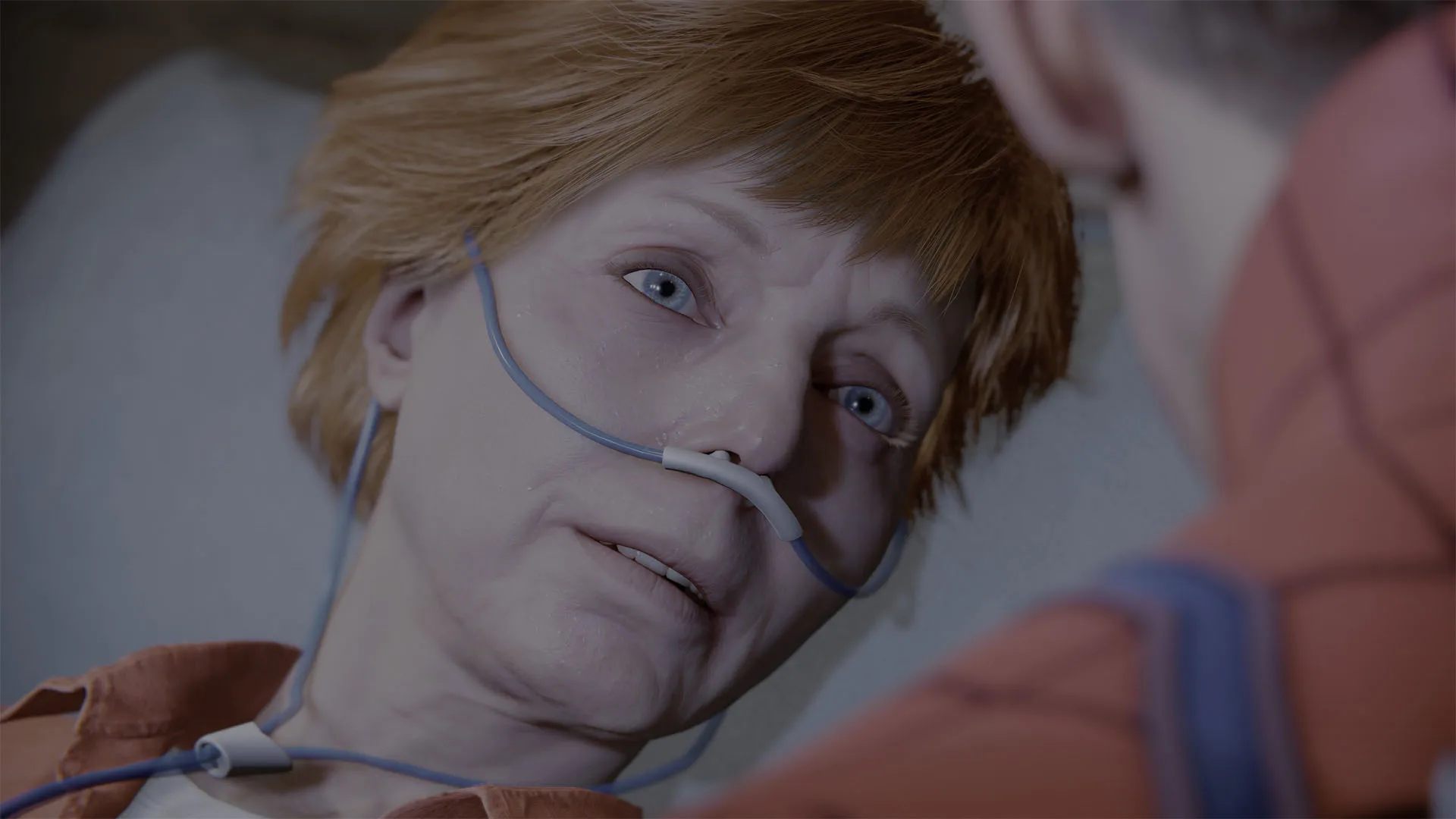
I agree that the game’s main quest is great – it’s Spider-Man and better than the movies and more like the comics. The map is shallow and the enemies are all very similar, but I like the ability to use different moves and costumes and to build Spider-Man the way I wanted. The interplay between Spidey and MJ is great, and also the heartfelt emotion-filled story about Miles and his hero dad. Surviving loss was well explored and even the motivations of the villains were detailed. Voice acting and audio are epic and they add to the enjoyment and immersion into Spider-Man’s world.
Spider-Man: Remastered is a solid PC port with a very good implementation of KB+mouse. Only once during a museum puzzle did I resort to using a controller. The reflections are outstanding and they exist everywhere in puddles, shiny floors, and in the glass skyscrapers that reflect light naturally. Reflections make the game come to life and there is a real sense of loss when ray tracing is turned off. 
I did not like many of the mundane side quests (‘the city is burning but save my pigeons’) and I skipped or left many unfinished except for the electrical/spectrograph puzzles which I am good at and really liked. On the other hand, Mario played the game on the PS5 and loved the side quests that introduce a plethora of characters which he said added to the story of your friendly neighborhood Spider-Man.
Mario’s comments follow:
One liners and boss battles are incredible and fun – It’s what the studio is known for, great set pieces but with uninspired goons in-between. The actual named characters are great and the MJ and Miles stealth missions were a nice change of pace but could annoy some gamers. It is silly that Spider-Man can stand there and “finish” goons while their buddies just watch, and it was unnecessary to change Spidey’s look to mimic Tom Holland. And although voice acting is great, Miles Morales’ voice is beyond wrong.
The PS5 has some issues and could look way better – as proven with the PC release – and I look forward to playing it again on PC. The issue is that the textures aren’t nearly as nice as PC. In comparison they can look washed out and missing some visual fidelity. The game deserves 8/10 as the definitive superhero game on console and PC. They took everything that worked for Batman and made it better for a young, fun, Spider-Man with an amazing supporting cast to boot.
Upscaling, Image Quality, and Performance
Spider-Man: Remastered features anti-aliasing solutions, SMAA, TAA, and NVIDIA’s DLAA as well as DLSS and AMD’s FSR 2.0 as upscaling solutions to improve framerates while maintaining image quality (IQ). DLAA is an NVIDIA-developed superior AI-enhanced form of TAA which has the best native render/display resolution visuals and is the best way to play on very powerful top RTX-powered PCs. As upscaling solutions, the Quality DLSS images are better than Quality FSR 2.0 with the camera in motion and with DLSS Quality being as good as the native 4K visuals and slightly sharper. Unfortunately, there is no sharpening slider and the overall images are too sharp.
FSR 2.0 is AMD’s latest iteration of FidelityFX Super Resolution. FSR improves performance by first rendering frames at a lower resolution and then by using an open-source spatial upscaling algorithm with a sharpening filter in an attempt to make the game look nearly as good as at native resolution. So far, there are 110+ available and upcoming games supporting FSR 1.0 and FSR 2.0. Although FSR 2.0 is a solid improvement over 1.0, it is still outclassed by DLSS, especially with the camera in motion.
More than three years ago, NVIDIA introduced real-time RTX ray tracing together with AI-powered Deep Learning Supersampling (DLSS). To play at high settings requires the use of AI super-resolution or DLSS which provides better than a game’s postprocessing AA together with improved performance. Spider-Man: Remastered uses ray tracing with DLSS or FSR 2.0 to improve performance, and we will compare the current performance and IQ of eleven AMD and NVIDIA ray tracing capable cards using the latest 516.94 GeForce and 22.8.1 Adrenalin drivers.
Performance Options and Test bed
Mark’s testing platform is an Intel Core i9-12900K, an ASUS ROG Maximus Apex Z690 motherboard, and 32 GB of T-Force DDR5 at 6400MHz on a recent clean install of Windows 11 Pro Edition. He compares image quality using DLSS versus FSR 2.0 and also using native TAA (and also DLAA for RTX cards), and we chart the performance of eleven current NVIDIA GeForce and AMD Radeon ray tracing capable cards:
- RTX 3090
- RTX 3080 Ti
- RTX 3080
- RTX 3070 Ti
- RTX 2080 Ti
- RTX 3070
- RTX 3060 Ti
- RTX 3060
- RX 6800 XT
- RX 6800
- RX 6700 XT
First, are compared ray traced reflections On versus Off in an indoor scene using completely maxed out settings and the very highest ray tracing options.
Ray Tracing On versus Off (Native 4/Maxed settings)
[twenty20 img1=”28514″ img2=”28513″ offset=”0.5″ before=”Ray traced reflections On” after=”Ray traced reflections Off”]
All of our images use maxed-out 4K settings with Very High ray tracing.
TAA vs. DLSS
Here are mostly uncompressed JPEG 4K images comparing No DLSS/Native/TAA (left) with Quality DLSS (right) using a slider.
[twenty20 img1=”28517″ img2=”28518″ offset=”0.5″ before=”Native/TAA 4K” after=”Quality DLSS 4K”]
We don’t recommend that RTX gamers play without DLSS at 4K. The DLSS image quality is equal or better/sharper than native/TAA – and especially with the camera in motion – although there are some very slight differences that can be seen with some minor DLSS specular aliasing issues visible on some surfaces and on rain drops. DLSS is perfect for 4K, but DLSS settings don’t scale well on 1440p and lower resolutions due to low GPU usage and high CPU limitation when using it.
TAA vs. DLAA
DLAA is an NVIDIA-developed superior IA-enhanced form of TAA which keeps native render/display resolution that only works on GeForce. However, DLAA comes with a small FPS cost, but the image quality is better than native 4K + TAA.
[twenty20 img1=”28518″ img2=”28519″ offset=”0.5″ before=”TAA ” after=”DLAA”]
If you have a powerful enough RTX-powered PC to run it, DLAA is the best choice for the ultimate image quality, especially at 1440p and 1080P.
DLSS vs. FSR 2.0
FSR 2.0 is AMD’s latest iteration of FidelityFX Super Resolution. FSR improves performance by first rendering frames at a lower resolution and then by using an open-source spatial upscaling algorithm with a sharpening filter. Its advantage is that it works on all cards, not just Radeons. Its disadvantage is that even the highest Quality FSR 2.0 setting does not maintain the high visual fidelity that Quality DLSS does, especially with the camera in motion.
[twenty20 img1=”28520″ img2=”28517″ offset=”0.5″ before=”4K Quality FSR 2.0″ after=”Quality DLSS 4K”]
FSR 2.0 is perfect for Radeons playing at 4K, but it doesn’t scale well on 1440p and lower resolutions due to Spider-Man: Remastered’s low GPU usage and high CPU limitation when using it.
There isn’t really a lot of visual difference that can be shown by screenshots.
Next, we check out the performance of eleven RTX cards using 3840×2160, 2560×1440, and 1920×1080 resolutions using up to three levels of DLSS with the goal of averaging close to 60 FPS while still using completely maxed-out settings.
Eleven Video Cards’ Performance Compared Using Maxed-out or the Very High Preset
First of all, no video card can play with fully maxed out settings at native 4K with TAA (or DLAA) and keep framerates above 60 FPS. The RTX 3090 cannot manage it, and most likely, neither can the RTX 3090 Ti. Here are the fully maxed-out settings (left) compared with the Very High Preset (right).
The Very High Preset uses High Reflections and Geometry details but using fully maxed-out settings they are set to Very High. In addition, the Object range increases from 6 to 10, and we also increased the Field of View. However, please note that we also increased the Anisotropic Filtering from 8X to 16X for all of our benching.
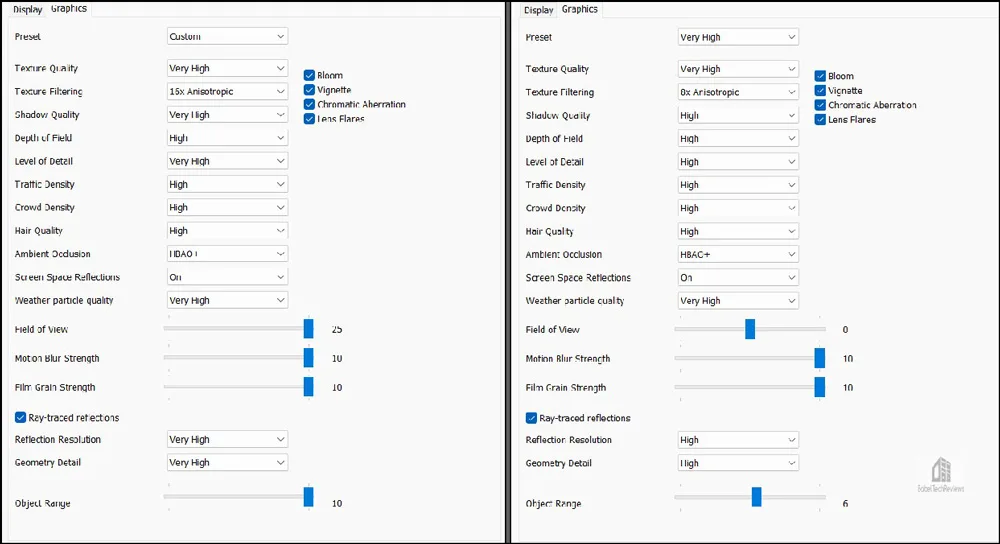
Let’s look at the performance of our 11 tested ray tracing capable video cards. All of the following charts show average framerates (FPS) in Bold and 1% FPS percentile minimums next to them in slightly smaller italized font.
4K Highest Setting Video cards – RTX 3080 Ti & RTX 3090
Only three cards can generally play at maximum settings at native 4K with TAA or DLAA.
The RTX 3090 and 3080 Ti are no-compromise video cards (together with the RTX 3090 Ti which we don’t have) that provide the best 4K Spider-Man Remastered experience. But none of them can handle fully maxed-out 4K settings without using DLSS. Quality DLSS provides an image quality experience that is arguably as good as native 4K with DLAA and better than native 4K with TAA.
We managed to play using native 4K and DLAA playing on an LG C1 120Hz G-SYNC OLED display with drops to the mid-50 FPS that did not impact our gameplay fluidity too badly. However, using Quality DLSS significantly improved the fluidity of the gameplay and did not impact the visuals during play. There is no reason to use FSR 2.0 even on its highest Quality setting with RTX cards as DLSS has better image quality with the camera in motion and the DLSS performance is a bit higher.
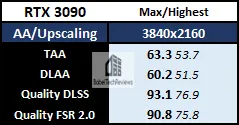
At maxed-out 4K, the RTX 3080 Ti also averages above 60 FPS with DLSS Performance but it drops into the lower 50s FPS for the 1% minimum lows. Dropping the settings from maximum to use the Very High preset allows RTX 3080 Ti players to enjoy framerates above 60 FPS even with native 4K/DLAA, but Quality DLSS provides a better and more fluid experience without compromising image quality.

1440p allows RTX 3090/3080 Ti gamers to enjoy even higher framerates and take advantage of 120Hz displays.
Other 4K video cards
The RTX 3080, RTX 3070 Ti, the RX 6900 XT, the RX 6800, and the RX 6800 are also able to play using the Very High preset by using DLSS or FSR 2.0. Unfortunately, we don’t have an RX 6900 XT to test.
The RTX 3080 can just manage 4K with TAA but not with DLAA which provides a superior image. It is far better to use Quality DLSS to not only enjoy superior visuals to TAA but to experience fluid framerates.
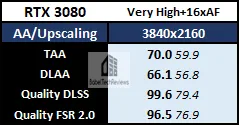
The RX 6800 XT requires Quality FSR 2.0 to achieve fluid framerates at 4K.

The RX 6800 performs similarly to the RX 6800 XT and can manage 4K/Very High above 60 FPS using FSR 2.0.

The following video cards perform well at 1440p.
1440P Video Car ds
The RTX 3070 Ti cannot play at Very High 4K without Balanced DLSS. It is best suited for 1440p since DLSS settings don’t scale well on 1440p and lower resolutions due to low GPU usage and high CPU limitations.
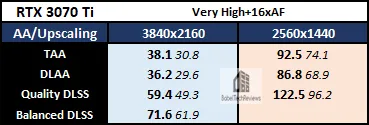
The RTX 3070 performs just below the RTX 3070 Ti in Spider-Man Remastered, and although it cannot play at all well at 4K/maxed, the same recommendations for 1440P apply as above.
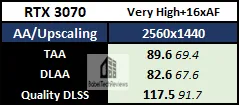
The last generation flagship RTX 2080 Ti also can easily manage 1440P with native DLAA but it may be better to use DLSS Quality for much higher framerates and better fluidity while swinging through the city
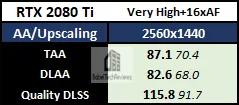
The RTX 3060 Ti can handle native 1440p although Quality DLSS provides an IQ alternative that is equal but with more fluid framerates.
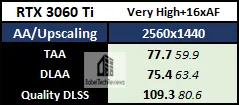
The RX 6700 XT can manage native 1440p/Very High but using Quality FSR 2.0 allows for higher framerates. It is also an excellent 1080P card since FSR 2.0 settings don’t scale well on 1440p and lower resolutions due to low GPU usage and high CPU limitations.

The RTX 3060 requires Quality DLSS to play at 2560×1440, but it is also well-suited as a 1080P card because of the same DLSS issues at lower resolutions due to low GPU usage and high CPU limitations.

DLSS and FSR 2.0 make a huge difference to the playability of Spider-Man: Remastered at either the highest visual quality settings or using the Very High preset at 4K. DLSS Quality has no IQ disadvantages whatsoever while FSR 2.0 makes minor visual differences while gaming. Both upscaling methods are highly recommended at 4K over using TAA except at 1440p and lower resolutions due to low GPU usage and high CPU limitation when using them, especially while swinging through the city.
Now let’s look at Rodrigo’s deep dive using the RTX 3080 and RX 6700 XT. The following is again in his words.
Rodrigo’s Deep Dive using the RTX 3080 and RX 6700 XT
Mark benchmarked the cards at “maxed-out” 4K and Very High 4K while I concentrated on 1440p “maxed-out” settings using an AORUS RTX 3080 MASTER, and on 1080P ‘”Very High (16xAF)” settings with a reference AMD Radeon RX 6700 XT.
My testing platform is a recent install of Windows 11 64-bit Pro Edition, an i9-12900K with stock clocks, an ASUS PRIME Z690-P D4 motherboard, and 32GB of T-FORCE XTREEM ARGB WHITE DDR4 3600MHz CL14.
I use CapFrameX for capturing and analyzing the relevant performance numbers obtained from our custom benchmark sequence. I always perform consecutive runs until detecting three valid runs (no outliers) that can be aggregated by CapFrameX using the following method:
-
- Aggregate excluding outliers:
- Outlier metric: Third, P0.2 (0.2% FPS percentile).
- Outlier percentage: 3% (the % the FPS of an entry can differ from the median of all entries before counting as an outlier).
- Aggregate excluding outliers:
WQHD (1440p) Performance Analysis Using an RTX 3080
We showcase Spider-Man: Remastered performance at 2560×1440 (1440p) or WQHD display resolution using an AORUS RTX 3080 MASTER graphics card at stock clocks.
In this section our “Maxed-out” graphics settings are as follows:

When needed for testing, we set ray-tracing reflection resolution and geometry detail settings in tandem and independently of any graphics quality preset or settings.
Graphics Quality Presets – Performance scaling
The charts below show the performance of each of the game’s graphics presets in terms of average FPS numbers for the raw performance, P1 and P0.2 metrics for frametimes consistency, and the corresponding performance scaling progression when we move between presets.
The above results showed how well and progressively the game scales performance on 1440p resolution when going from “Very High” preset to “Very Low” in terms of both IQ and GPU workload levels. Although we saw significant raw performance improvements when moving from the “Very High” preset to the “Very Low” preset, the frametime consistency or stability kept similar across all graphics presets. Also, moving from the “Very High” to “High” preset gives you the highest FPS avg gain.
The following charts support these findings and show that the graphics preset with the worst frametime stability and frame-pacing is the “Very High” preset, comparatively.
We next present our ray-tracing and NVIDIA DLAA vs. TAA results using an RTX 3080 at 1440p resolution.
Ray-Tracing Performance – Settings & DLAA vs. TAA
Here we see the high FPS cost of enabling real-time ray traced reflections in Spider-Man Remastered, up to about 42% less raw performance. We also see that, while the difference when using DLAA or TAA is relatively minor when using “Maxed” settings and “Very High” ray-tracing settings, this difference increases significantly with “High” ray-tracing settings and notably when ray-tracing is off.
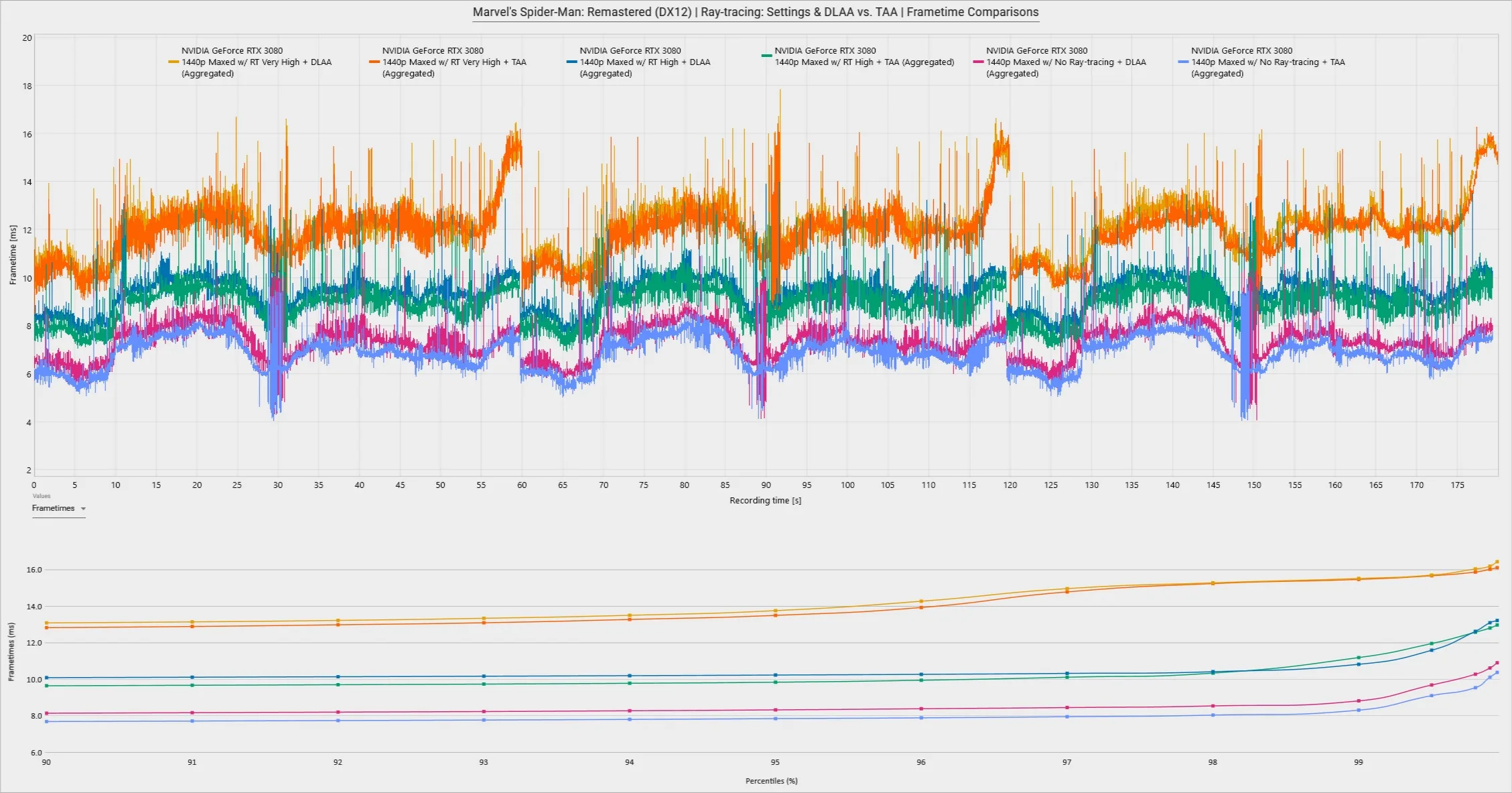
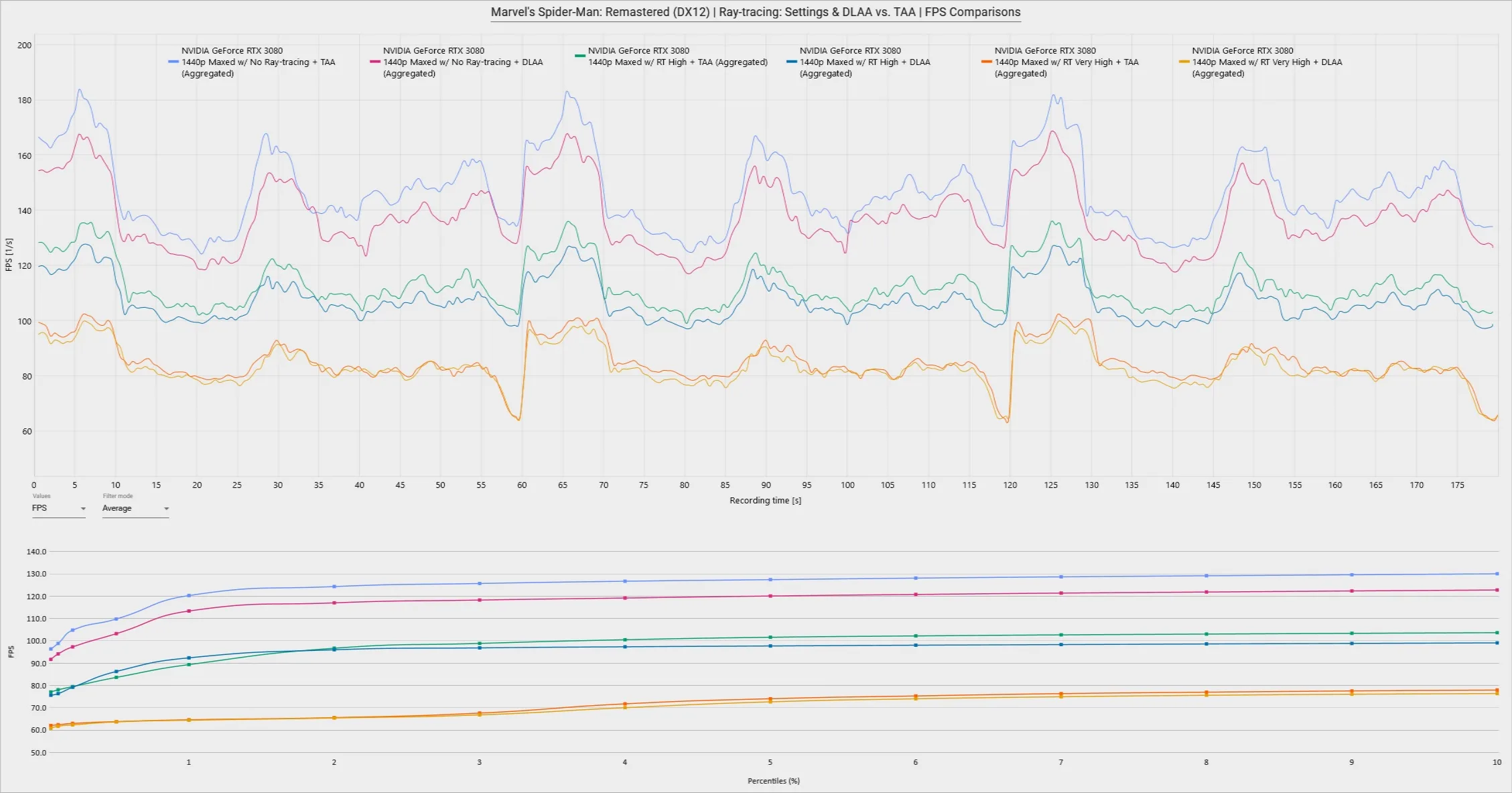
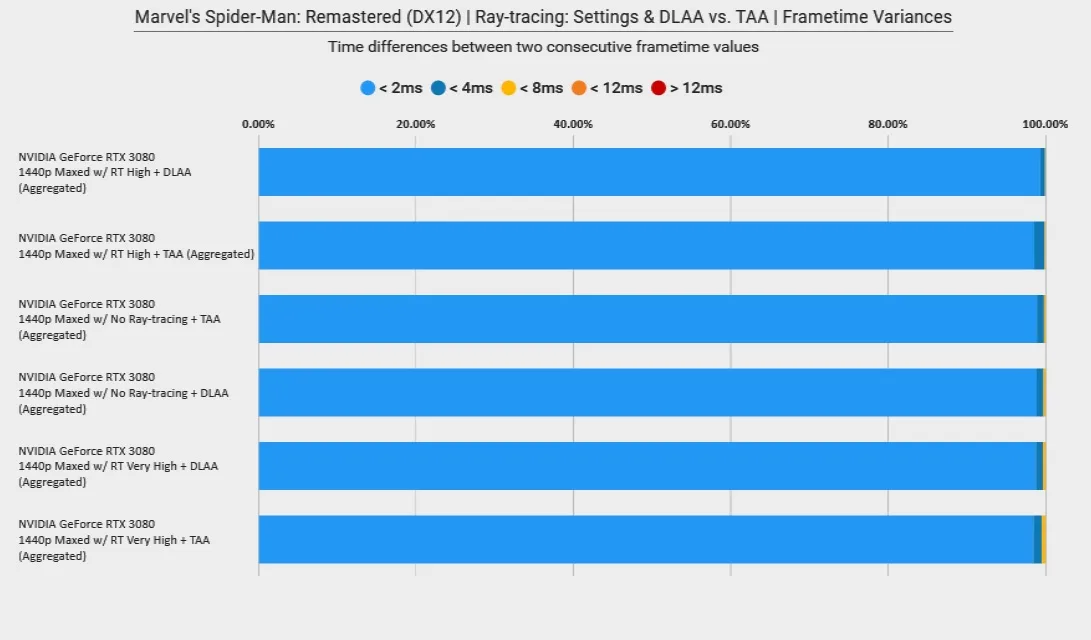 The charts above show that while the ray-tracing “Very High” scenarios showed the worst frametime consistency or stability, the ray-tracing “High” settings scenarios were the most consistent or stable. Besides, although the differences in frametime variances were minor, we saw that the “High” ray-tracing scenario with DLAA had overall the best frame-pacing and “very high” ray-tracing with TAA the worst.
The charts above show that while the ray-tracing “Very High” scenarios showed the worst frametime consistency or stability, the ray-tracing “High” settings scenarios were the most consistent or stable. Besides, although the differences in frametime variances were minor, we saw that the “High” ray-tracing scenario with DLAA had overall the best frame-pacing and “very high” ray-tracing with TAA the worst.
Our NVIDIA DLSS and AMD FSR 2.0 results using an RTX 3080 at 1440p resolution are next.
NVIDIA DLSS Performance – Settings
We see that while the performance gain is notable when we turn on DLSS scaling (up to about 21%), the relative raw performance gains are smaller overall when we move from the “DLSS Quality” setting to “DLSS Balanced” and from “DLSS Balanced” to “DLSS Performance” mode. That’s why we consider that in terms of performance and image quality, it makes little sense to use a setting other than DLSS Quality when you play at 1440p resolution.
In this regard, our tests also showed that using any DLSS setting is consistently associated with low GPU usage and CPU-boundedness. This situation is especially noticeable when our Spider-Man is outdoors and swinging between buildings.

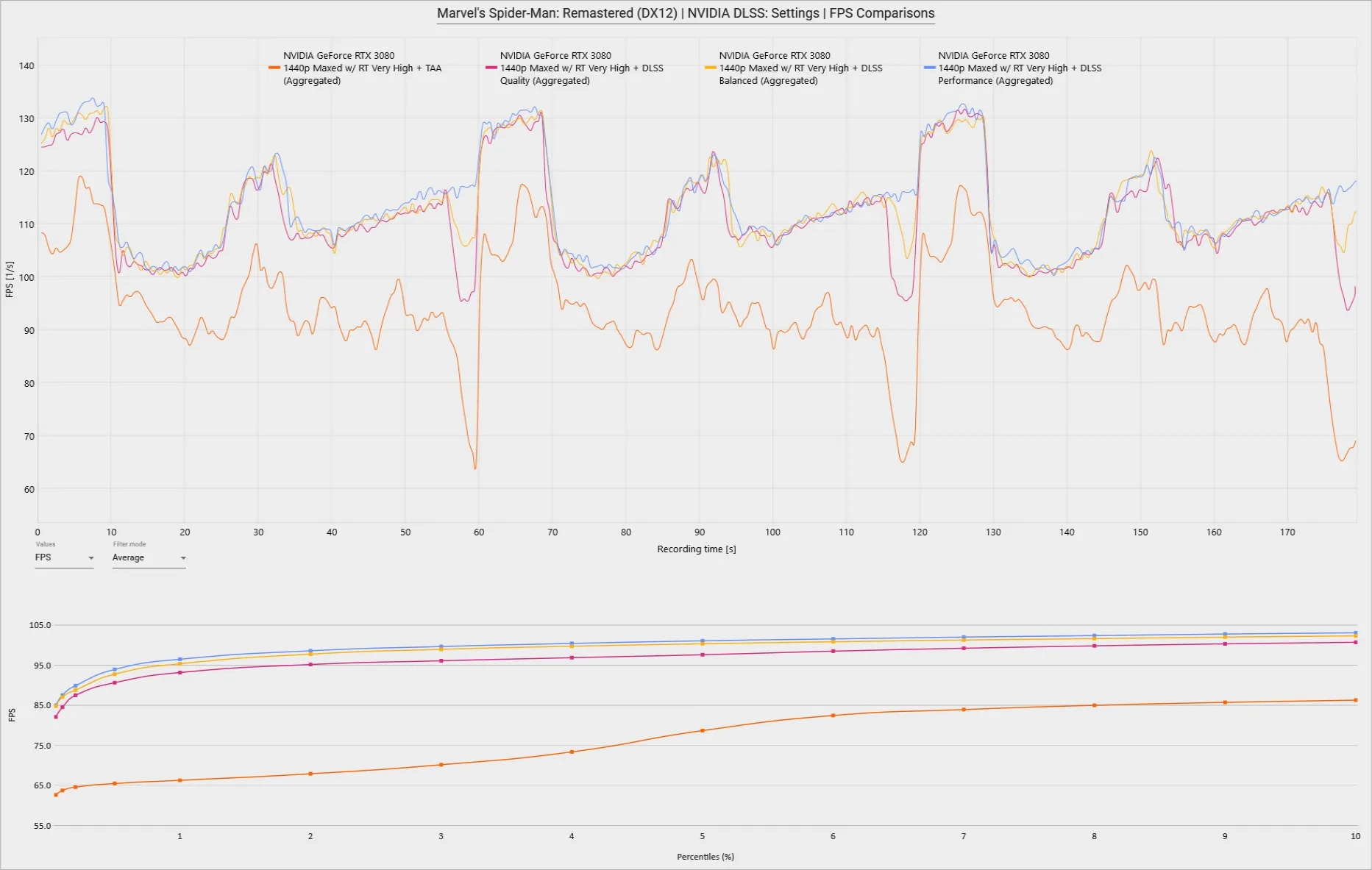
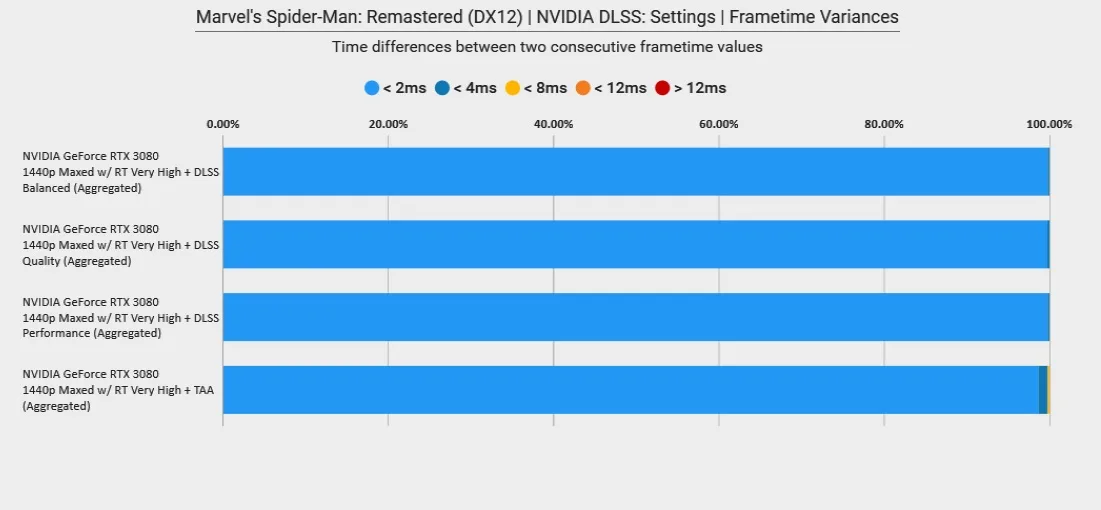 Based on the charts above, we also see that using DLSS with ray-tracing gives significant performance gains in frametime consistency or stability and frame-pacing.
Based on the charts above, we also see that using DLSS with ray-tracing gives significant performance gains in frametime consistency or stability and frame-pacing.
AMD FSR 2.0 Performance – Settings
The charts above show a similar performance scaling trend as we saw with DLSS settings. While we see a notable performance boost as soon as we enable AMD FSR 2.0 scaling (up to about a 20% gain), we found minor performance changes when swapping between FSR 2.0 modes. Also, the frametime consistency or stability was better using the AMD FSR 2.0 scaling method.
The next charts support these findings and show that you get a better frame-pacing when using AMD FSR 2.0 scaling settings.
Therefore, DLSS and FSR 2.0 scaling methods can also help smooth out your gaming experience in this game.
Below are our DLSS vs. FSR 2.0 performance comparisons
DLSS vs FSR 2.0 Performance
Although the game’s performance scaling behavior is overall the same using NVIDIA DLSS and AMD FSR 2.0 technologies, we consider NVIDIA DLSS the best AI-enhanced scaling method in terms of IQ when using an RTX graphics card.
We also don’t see significant performance differences in frametime consistency or frame-pacing between DLSS and AMD FSR 2.0 settings.
Full HD (1080p) Performance Analysis Using a Reference RX 6700 XT
Next is our in-depth Spider-Man: Remastered performance analysis at 1080p or Full HD display resolution using a reference AMD Radeon RX 6700 XT card with stock clocks.
In this section our “Very High (16xAF)” graphics settings are as follows:

When needed for testing, we set ray-tracing reflection resolution and geometry detail settings in tandem and independently of any graphics quality preset or settings.
Graphics Quality Presets – Performance scaling
Using our reference RX 6700 XT graphics card at 1080p resolution, we see overall the same performance scaling trend as we found with our AORUS RTX 3080 MASTER. That is, a higher performance improvement when we move from the “Very High” to “High” preset, but lower average FPS gains when we move to the rest of the graphics quality presets.
“High” is the steadiest graphics quality preset, and “Very High” is the less smooth one using our reference RX 6700 XT at 1080p resolution. Also, all presets show an overall similar frame-pacing.
We next present our ray-tracing performance charts using a reference RX 6700 XT at 1080p resolution.
Ray-Tracing Performance – Settings
Here we see again the high FPS cost of enabling ray traced reflections in Spider-Man Remastered, up to about 44% less raw performance at 1080 resolution using our reference RX 6700 XT. Going from ray-tracing “High” settings to ray-tracing “Very High” shows a 17% loss in FPS avg, a 32% FPS avg decrease going from no ray-tracing to “High” ray-tracing settings, and a 44% reduction going from no ray-tracing to “Very High”ray-tracing settings.
From the charts, we also see that “High” ray-tracing is overall the steadiest testing scenario. Here the frame-pacing was similar in all tested configs.
AMD FSR 2.0 Performance – Settings
Again, the FSR 2.0 Quality setting provides the best performance and image quality benefits. Our tests using any FSR 2.0 scaling setting also showed low GPU usage and CPU-boundedness, consistently. This situation is especially noticeable when our Spider-Man is outdoors and swinging between buildings.
Here we see that using any FSR 2.0 scaling setting helps us significantly improve frametime consistency or stability and frame pacing slightly.
Let’s head to our conclusion.
Conclusion
Spider-Man: Remastered is an immersive, outstanding, and really fun game that gives a great cinematic experience while telling an extraordinary story. We are especially impressed by its visuals coupled with the large free performance increase that DLSS and FSR 2.0 brings for PC gamers.
If you like Spider-Man movies and/or the comics, Remastered is a must-play game that is better than the films. And if you are looking to play the game with the best framerates and the very highest image fidelity, then choose DLSS or FSR 2.0 depending if you are a GeForce or Radeon gamer. Spider-Man: Remastered is the kind of deeply immersive game that makes a player forget everything – food, chores, work, and even pain.
All of BTR’s three editors agree that Spider-Man: Remastered is a very good game that deserves at least an 8.0/10. Recommended!
Stay tuned to BTR!
Happy Gaming!

